Introduction
Huawei has been the company to experiment the most with the foldable form factor through the years. It was just recently that we reviewed the Mate X6, one of the thinnest mainstream foldables, and with the Mate XT Ultimate here, Huawei has yet again redefined what a foldable is.
And while the Mate X6 is a foldable phone, the Mate XT Ultimate is more like a foldable tablet! It features a whopping 10.2-inch LTPO OLED screen with 360ppi resolution, 90Hz refresh rate, and 10-bit color depth. This large 16:11 display can be folded one or two times, depending on your preferences and use case.
Huawei has invented two different high-precision hinges for the purposes of the XT design, which are durable yet incredibly thin, and allow the device to remain as thick as a recent Galaxy Z Fold when completely closed. But when it's completely open, this new Mate is only 3.6mm thin!
The Mate XT Ultimate runs on Huawei's own Kirin 9010 - it's a step back from the Kirin 9020, which powers the Mate X6. It's coupled with 16GB RAM and you can get the device with up to 1TB of storage.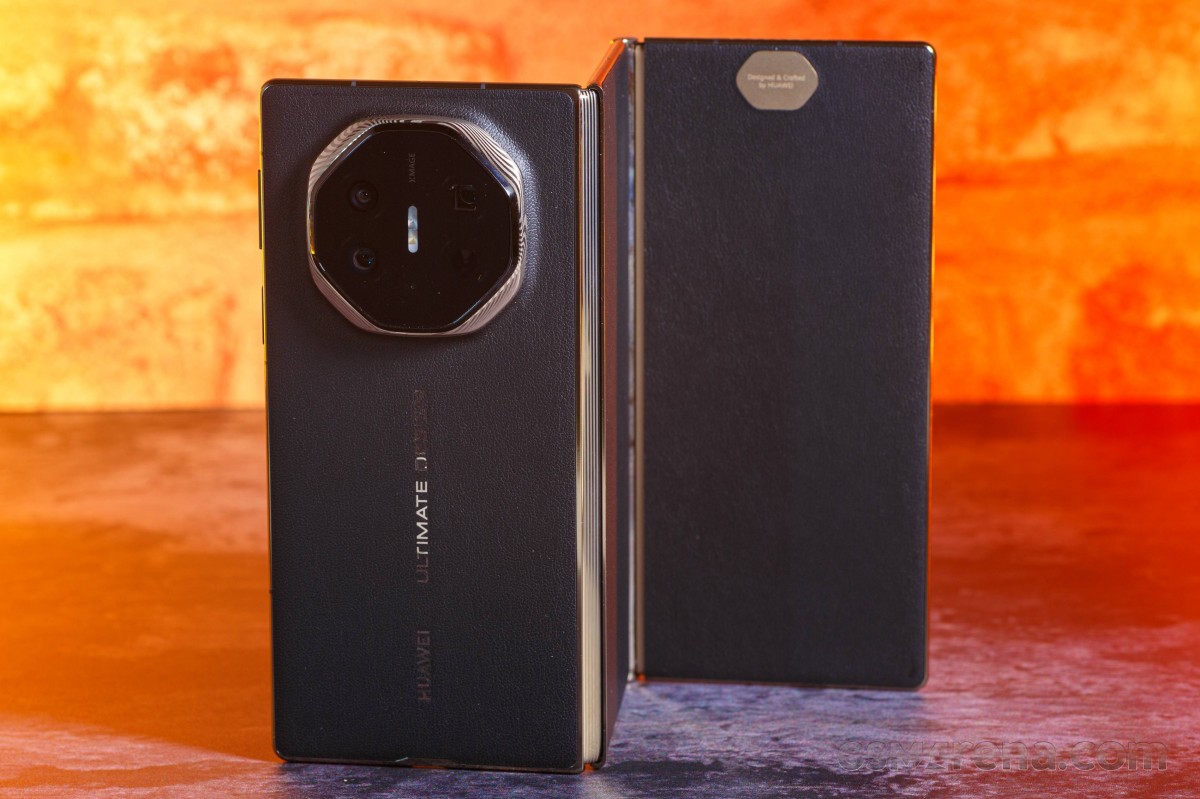
Huawei phones have been known for their solid photographic chops and we expect that to be the case with the Mate XT. The rear setup, which can also be used for selfies, has a 50MP primary camera with OIS and a variable aperture, a 12MP 5.5x zoom camera with a periscope telephoto lens, and a 12MP AF ultrawide camera. Laser assistance and a color spectrum sensor complement the back cameras. There is also a small 8MP imager inside a cutout in the screen.
The Mate XT has what appears to be three connected batteries with Si/C composite anode and a total capacity of 5,600mAh. There is 66W wired and 50W wireless charging support, as well as reverse wireless charging.
This innovative foldable tablet boots EMUI 14.2 or Harmony OS 4.2, depending on your region.
Huawei Mate XT Ultimate specs at a glance:Body: 156.7x219.0x4.8mm, 298g; ultra-thin glass, vegan leather back, metal frame.
Display: 10.20" Tri-foldable LTPO OLED, 1B colors, 90Hz, 2232x3184px resolution, 12.84:9 aspect ratio, 381ppi; Cover display (1/3 of the main display): 6.4 inches, 1008 x 2232 pixels, Dual display (2/3 of the main display): 7.9 inches, 2048 x 2232 pixels.
Chipset: Kirin 9010 (7 nm): Octa-core (1x2.3 GHz Taishan Big & 3x2.18 GHz Taishan Mid & 4x1.55 GHz Cortex-A510); Maleoon 910.
Memory: 256GB 16GB RAM, 512GB 16GB RAM, 1TB 16GB RAM.
OS/Software: HarmonyOS 4.2 (China).
Rear camera: Wide (main): 50 MP, f/1.4-f/4.0, 24mm, PDAF, OIS; Telephoto: 12 MP, f/3.4, 125mm, PDAF, OIS, 5.5x optical zoom; Ultra wide angle: 12 MP, f/2.2, 13mm, 120˚, PDAF.
Front camera: 8 MP, f/2.2, (wide).
Video capture: Rear camera: 4K, 1080p, gyro-EIS, OIS, HDR; Front camera: 4K, 1080p.
Battery: 5600mAh; 66W wired, 50W wireless, 7.5W reverse wireless, 5W reverse wired.
Connectivity: 5G; Wi-Fi 6; BT 5.2, L2HC; NFC; Infrared port.
Misc: Fingerprint reader (side-mounted); stereo speakers; BDS Satellite Calling and Messaging - China only.
The Kirin 9010 offers mid-range performance compared to other chipsets and it is limited to 4G connectivity outside China. Another potential setback is the lack of water resistance.
Of course, the biggest omission in the eyes of a Western reader will remain the lack of a newer Android version and Google Mobile Services. While Google apps and services can be installed easily via something like GBox or microG, sooner or later, you will run into an incompatible app there.
Unboxing the Huawei Mate XT Ultimate
The global version of the Mate XT Ultimate arrives in a large box that contains the phone, a USB-C cable and an Aramid Fiber Case with an integrated rotating stand.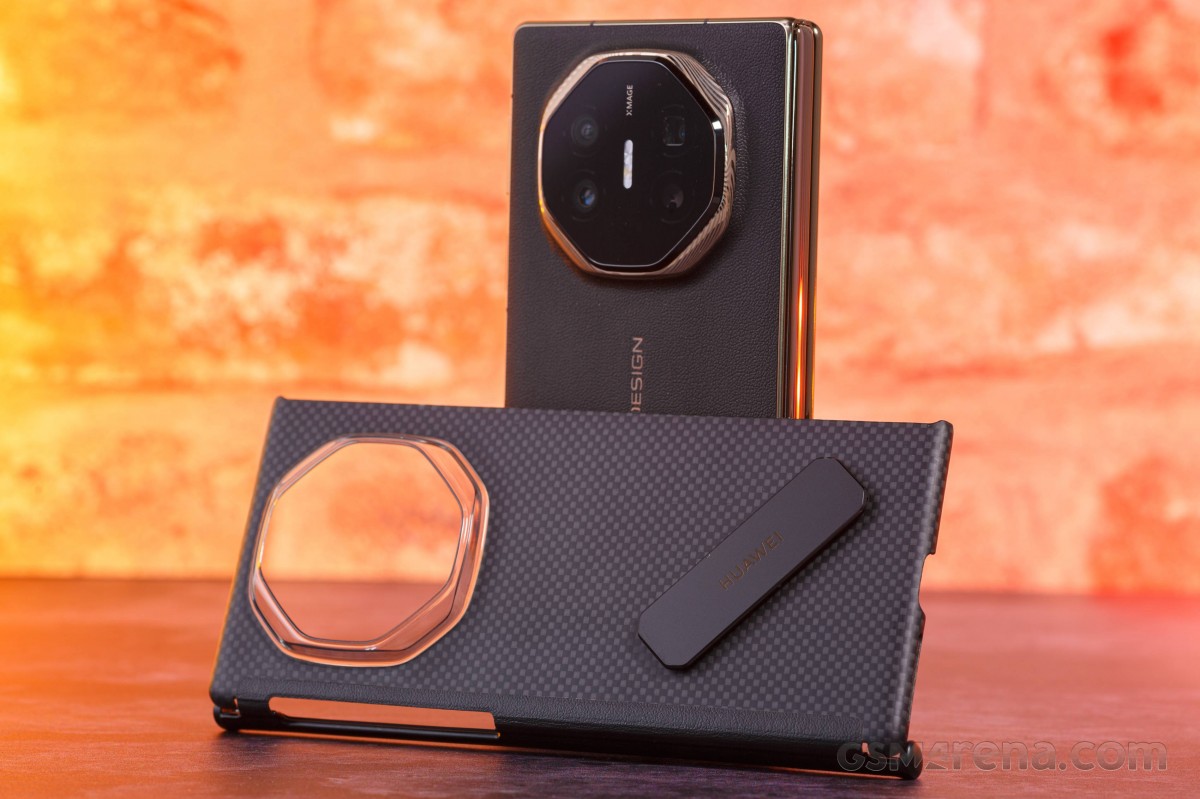
This stand certainly comes in handy, especially if you make use of the built-in kickstand, but overall, it's not the most convenient as it has a flap covering the part of the exposed part of the folded screen. The flap gets in the way of conveniently unfolding the screen from a fully closed to a fully unfolded position.
Finally, some markets will also get a 66W power adapter in the retail box so do check with your retailer.
Design, build quality, handling
The Huawei Mate XT Ultimate is like no other smartphone on the market and it is so good to see real innovation for a change. We miss the golden days back when manufacturers weren't afraid of experimenting with phone designs, and we will always appreciate when brands that try something different.
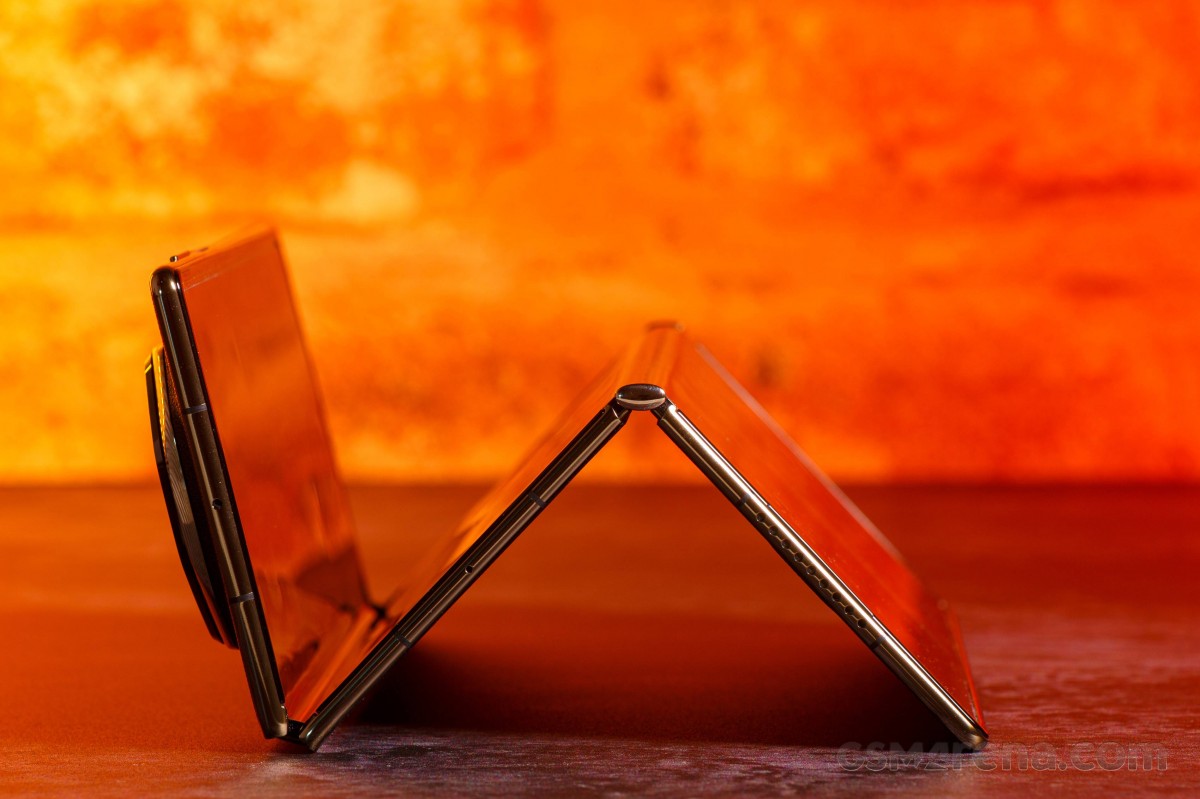
But Huawei did not only try to make the first truly foldable tablet, it succeeded. The device has a proper tablet-level screen size of 10.2 inches but also a proper tablet-grade screen aspect of about 16:11. Those are very iPad-like numbers.
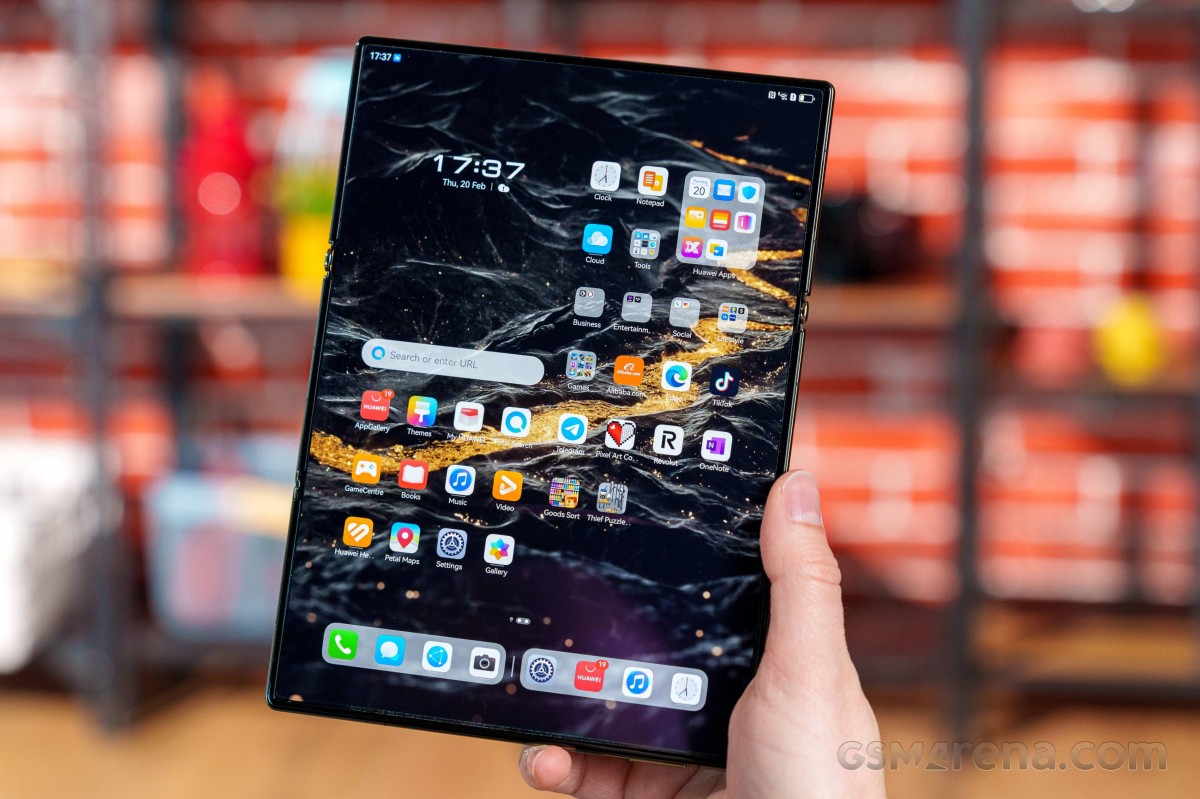
Having such a large screen, trifold at that, would usually mean a thick, bulky device. That's not the case with the Mate XT, though. On the contrary, Huawei has designed this foldable slate to be incredibly thin - just 3.6mm when opened, and 12.8mm when closed. That latter dimension matches the most popular foldable out there - the Galaxy Z Fold6!
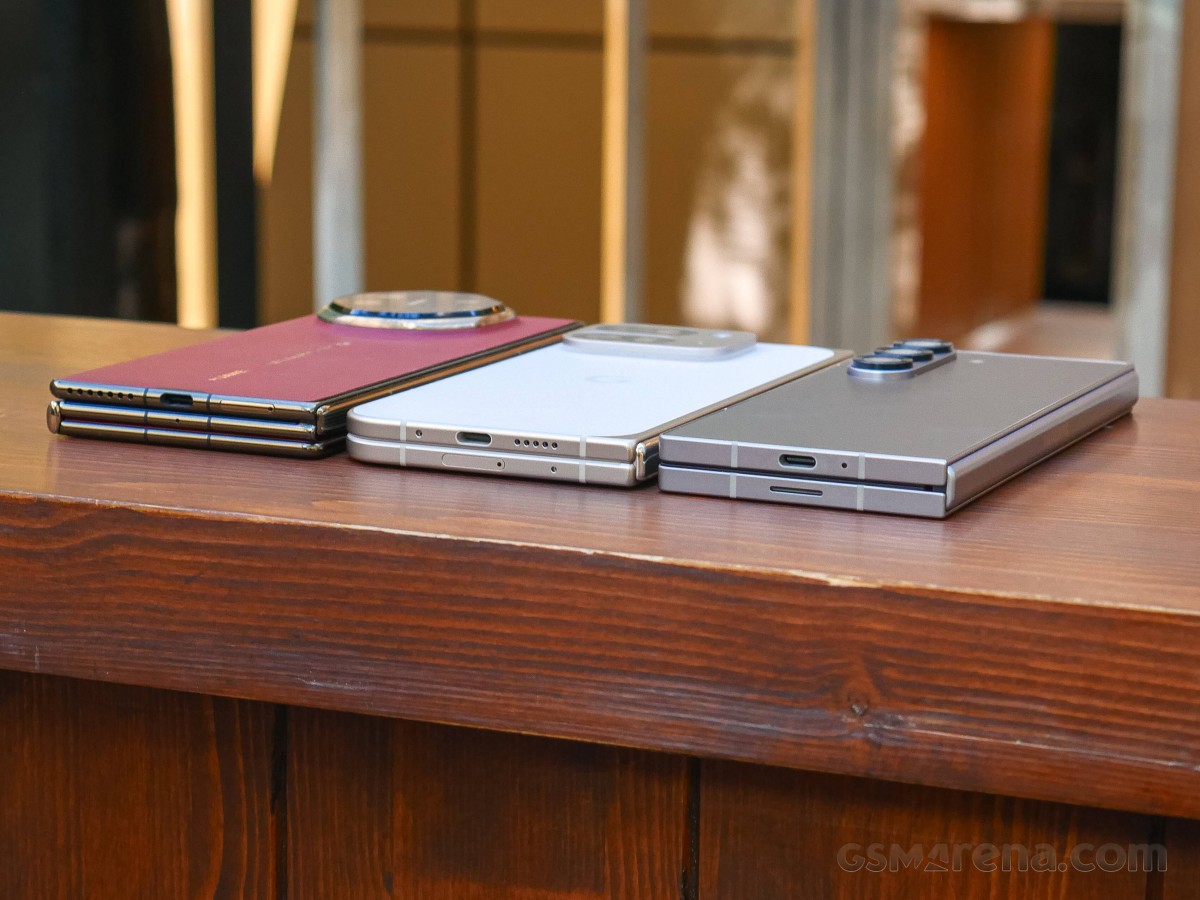 Huawei Mate, Google Fold, and Galaxy Fold
Huawei Mate, Google Fold, and Galaxy Fold
The Huawei Mate XT Ultimate is made of premium materials all-around - there is a super thin rounded metal frame, stainless steel hinges, and a stainless steel camera housing enclosure. The back is covered with either red or black vegan leather, while the tri-fold screen has a layer of ultra-thin glass inside.
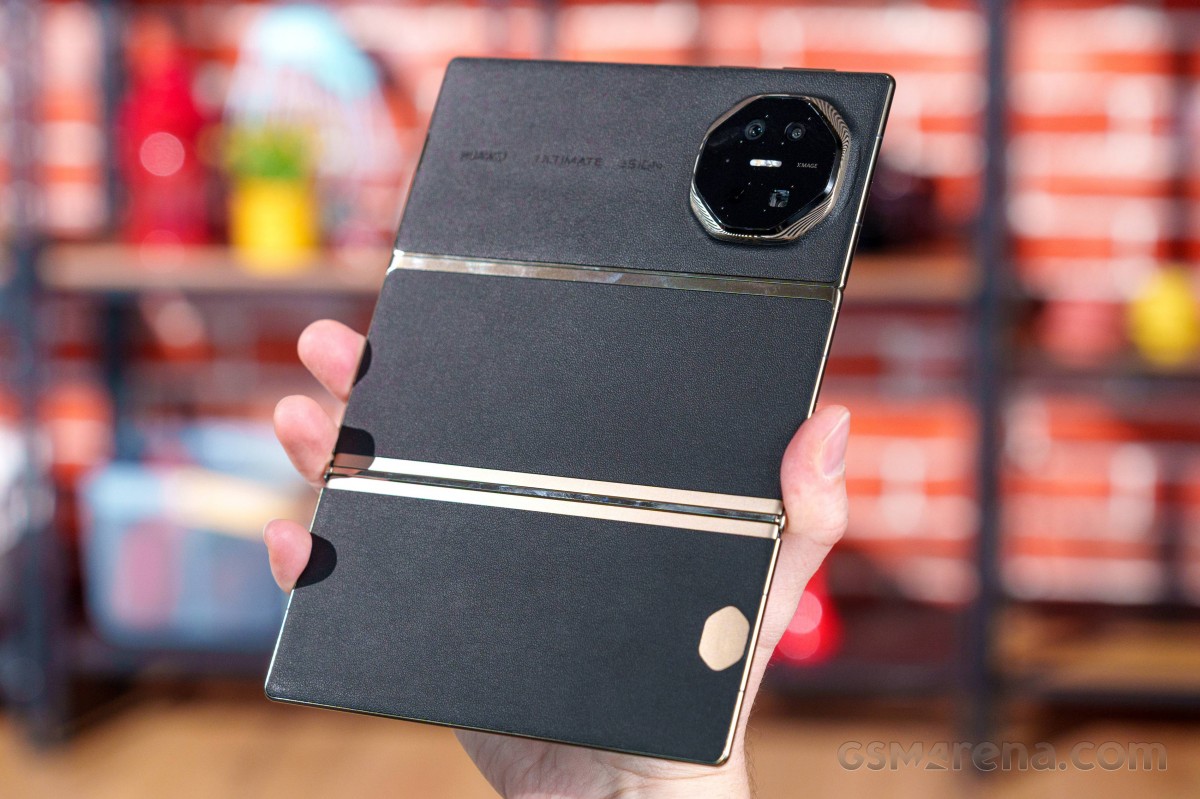
The camera housing has been crafted in a very special way, using 80 layers of stainless steel, twisting them, and polishing them. The result is a unique star-shaped piece, that has a different pattern on each phone!
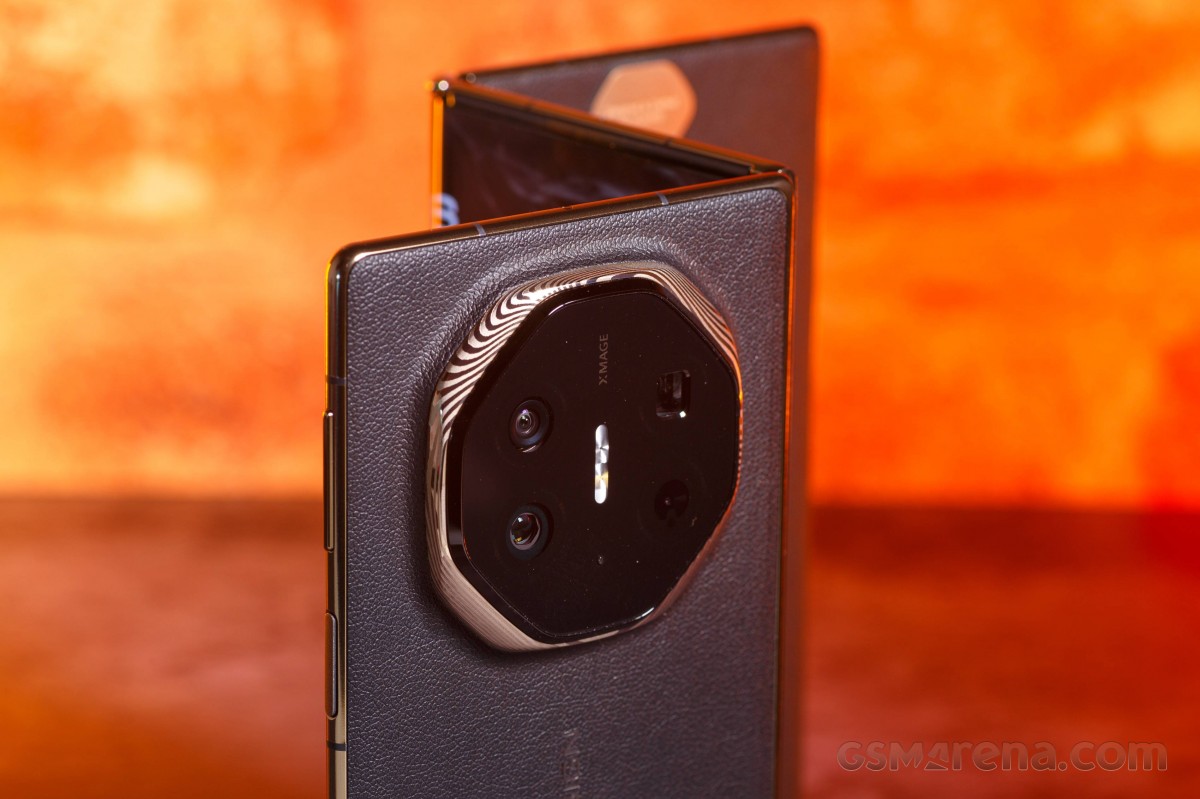
When folded, the Mate XT looks like a thick smartphone with a regular 6.4-inch OLED screen. If you look closely, you can see the small perforation for the 8MP selfie camera, and even a thin earpiece. There is no proximity sensor on the Mate XT - it relies on a software implementation, and it works quite well, we'd say.

You can fold the Mate XT in a way that mimics a regular foldable screen with a 7.9-inch squarish display.
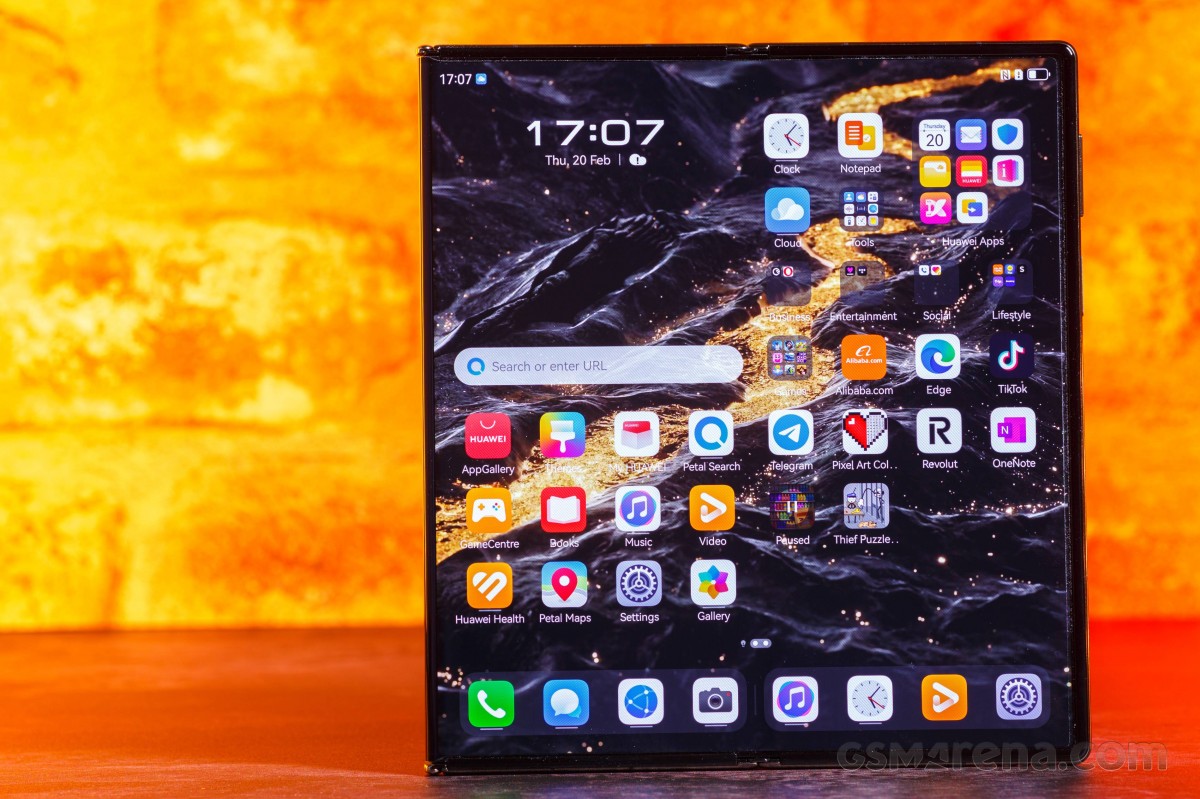
And then, in its fully opened state, Mate XT offers a 10.2-inch OLED screen with a 16:11 aspect ratio. You can notice the usual plastic enclosure around the screen, something that is obvious on any foldable phone. And you should not remove the sort of visible protective film, as this will damage the screen.
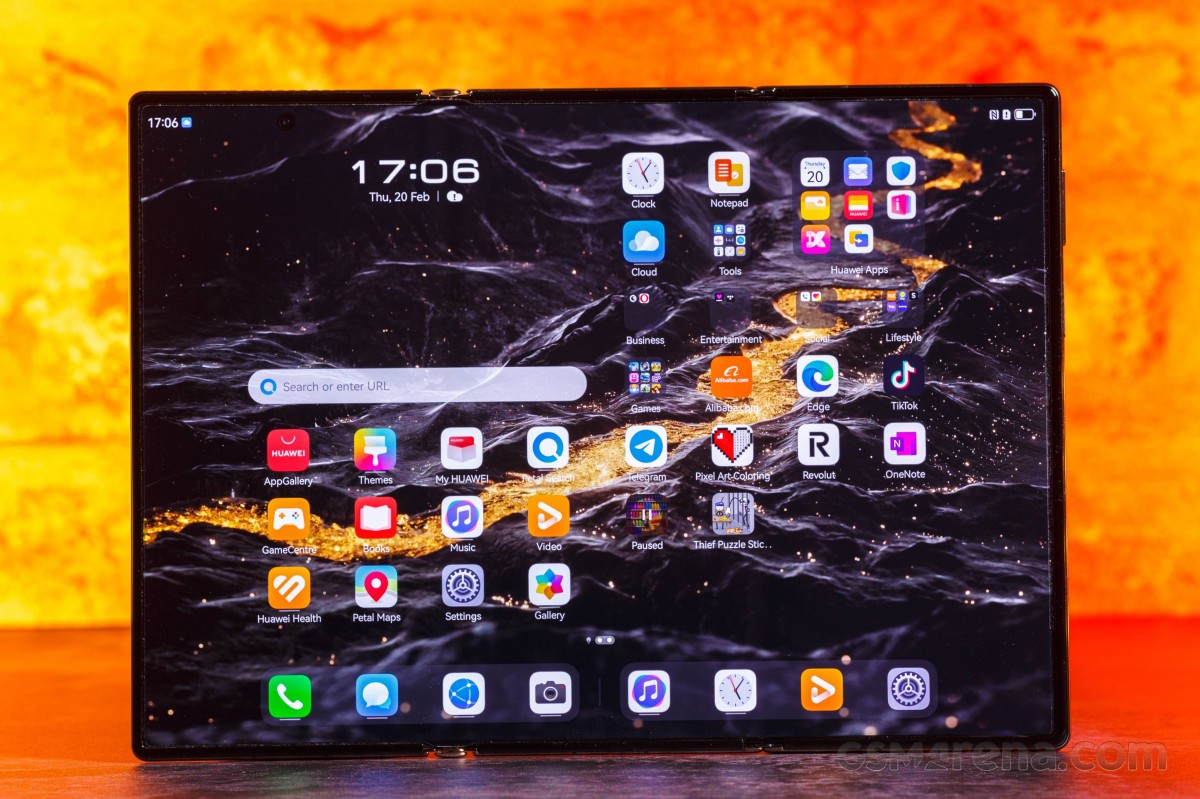
The Mate XT is incredibly thin when opened, though in this state, the relatively large camera housing makes it wobble a whole lot.

If you use this large screen estate in portrait mode, the Mate XT feels exactly like a regular-sized tablet, be it an iPad or something else.
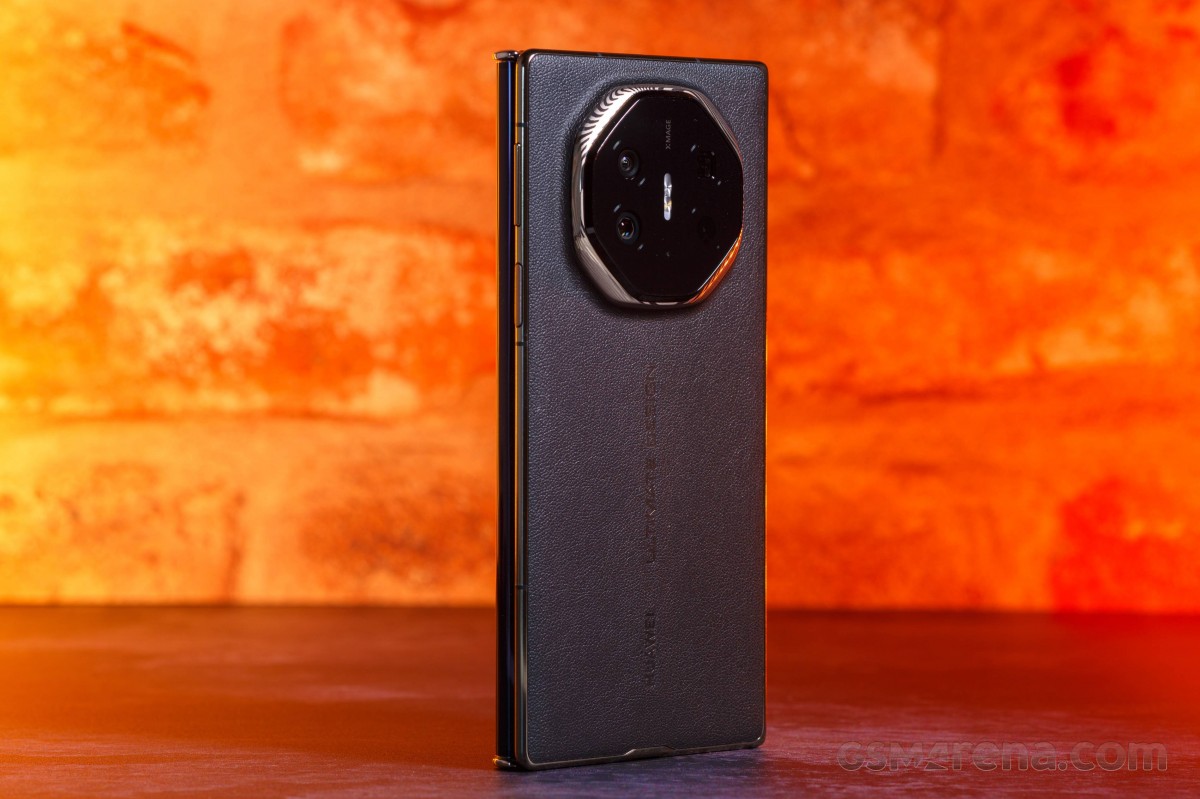
The entire back is covered with fingerprint-resistant vegan leather in either black or red.
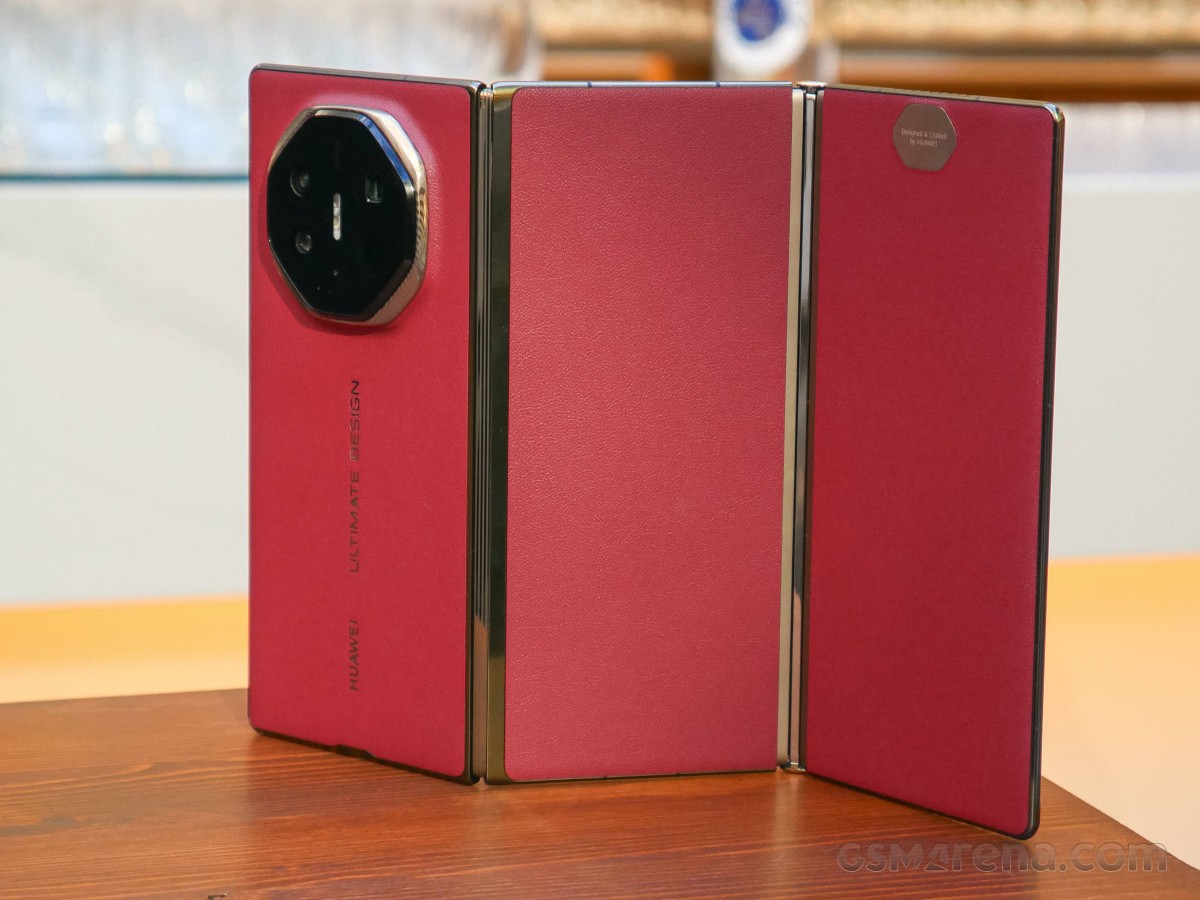
And then there is a Mate X6-reminiscent camera housing with the twisted pattern we mentioned above. This oversized setup includes a 50MP primary camera with variable aperture, a 12MP 5.5x telephoto, a 12MP ultrawide camera, a laser emitter/receiver combo, a dual-LED flash, and a color spectrum sensor. A microphone is also around.
The top side of the frame has one of the speakers, an IR blaster, and another microphone.
The primary mic, the USB-C port, the SIM bed, and the other speaker are at the bottom.
The Mate XT relies on a side-mounted fingerprint sensor for biometric security, which is not the most comfortable to use in the fully open state, but it is better than nothing.
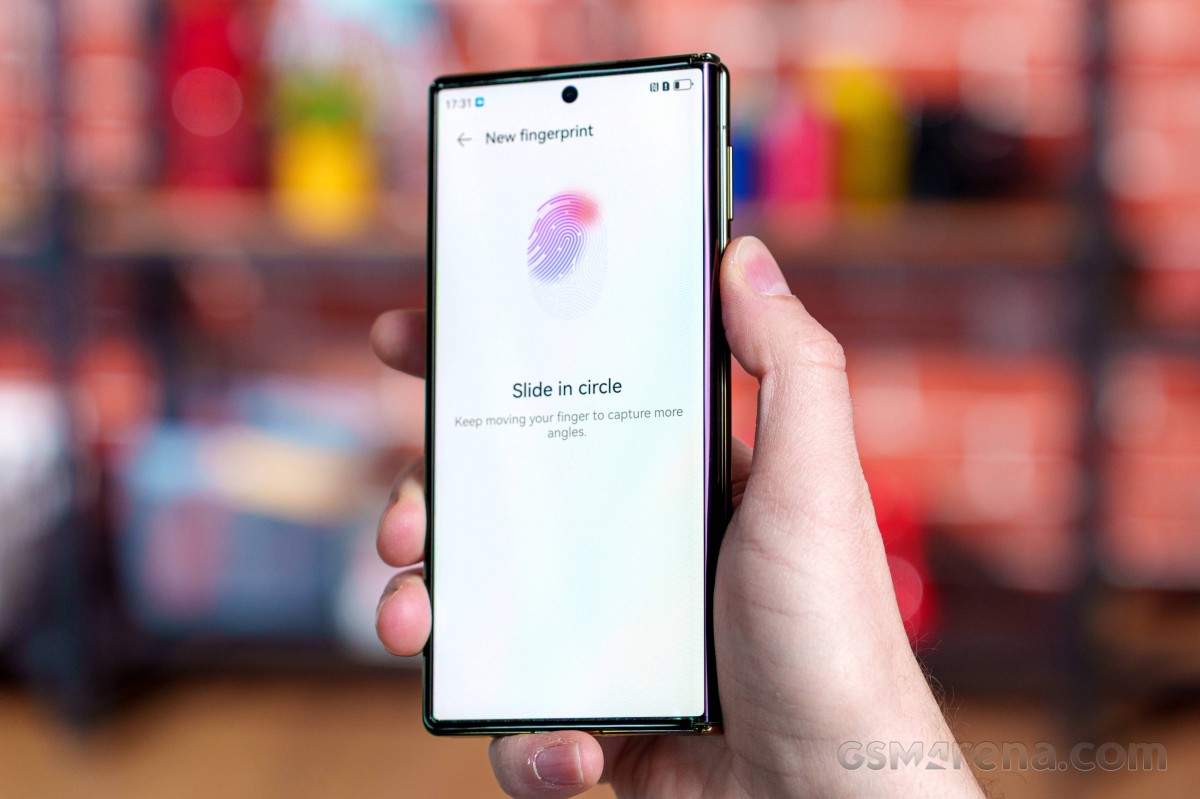
The Mate XT is an exquisite device, premium and innovative, one that easily stands out no matter the crowd or the situation. And it offers exceptional flexibility and usability; there are no two ways about that.
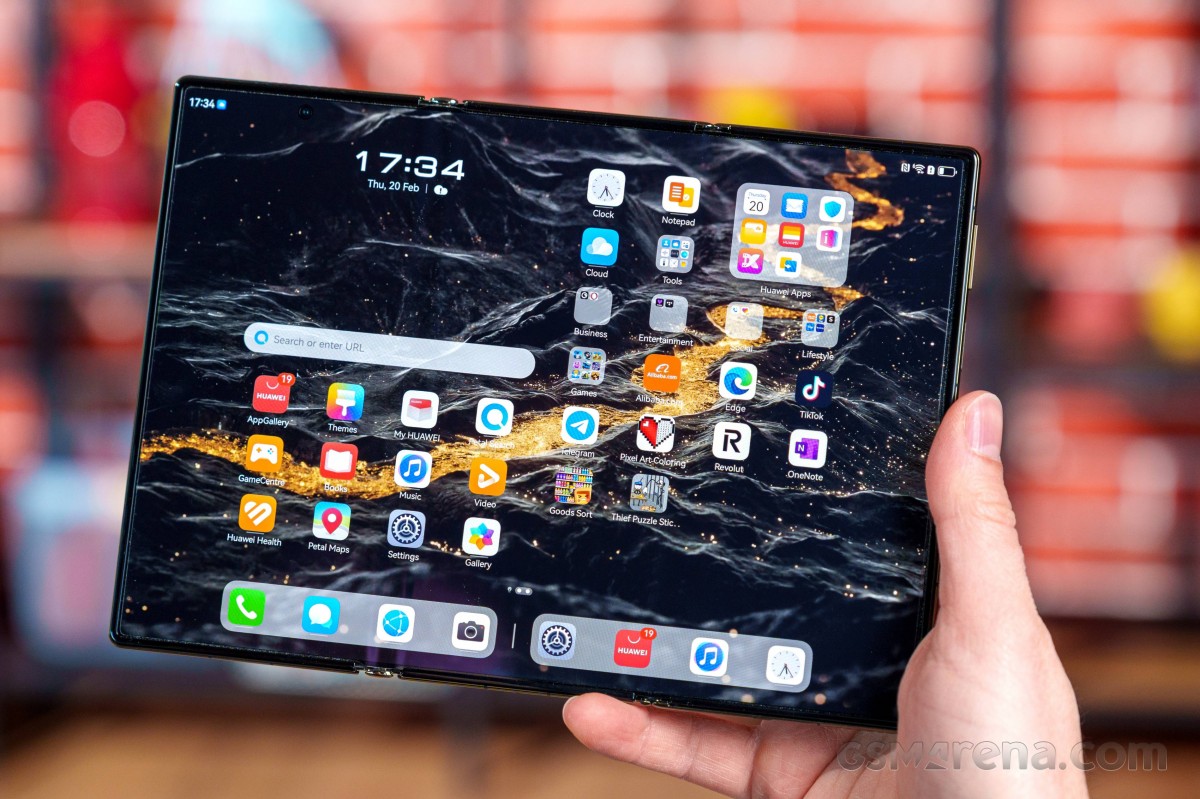
Prop it up with the bundled case, and its kickstand transforms the Mate XT into a portable monitor or sorts - a great way to watch TV series or YouTube during your lunch break.
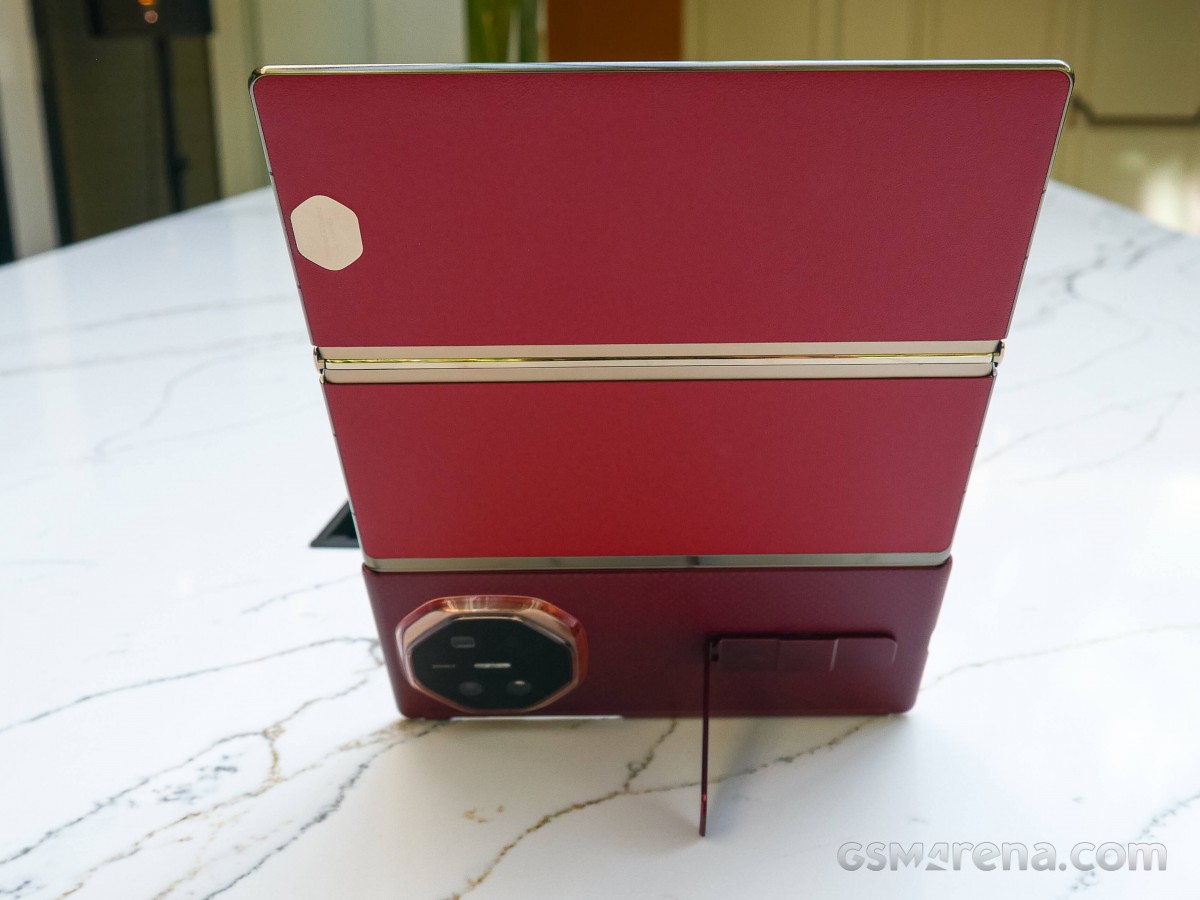
The Huawei Mate XT is comfortable to use and secure enough in your hands, no matter how many thirds of the screen you have in operation. We only wish it had some sort of water protection - even a basic IPX4-grade water resistance would have been better than nothing.
A trifold screen like no other
The showstopper on the Huawei Mate XT Ultimate is the 10.2-inch trifold LTPO OLED screen, of course. It's got a 10-bit color depth, 90Hz refresh rate, 240Hz touch sampling, and 1440Hz PWM dimming. In its fully open state, it has a 3,184x2,232px resolution, for an aspect ratio of 16:11(.2), or 1.43:1 if that's how your brain works.
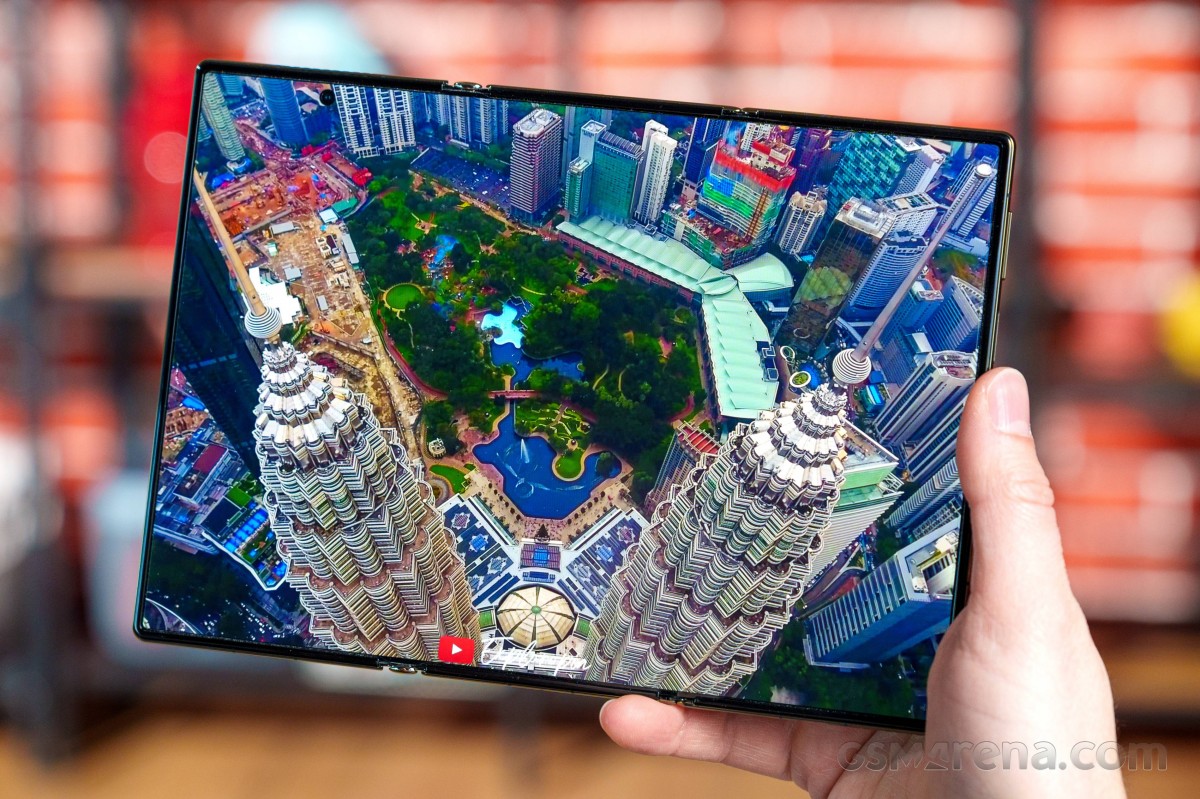
The Mate XT offers three screen sizes. The most impressive one is in tablet mode, obviously - a 10.2-inch diagonal. Then there is a 6.4-inch single screen when folded into smartphone state, and there's an inbetween 7.9-inch dual-pane option when you unlatch one side.
There's a pretty obvious screen crease at each fold, though the two are a little different in feel and appearance. Either one feels like it's a generation or two away from the current batch of Chinese foldables which have minimized their creases to nearly indistinguishable levels. Other than that, we can't find many faults with the screen. It's vivid, bright and the immense diagonal is great for content consumption.
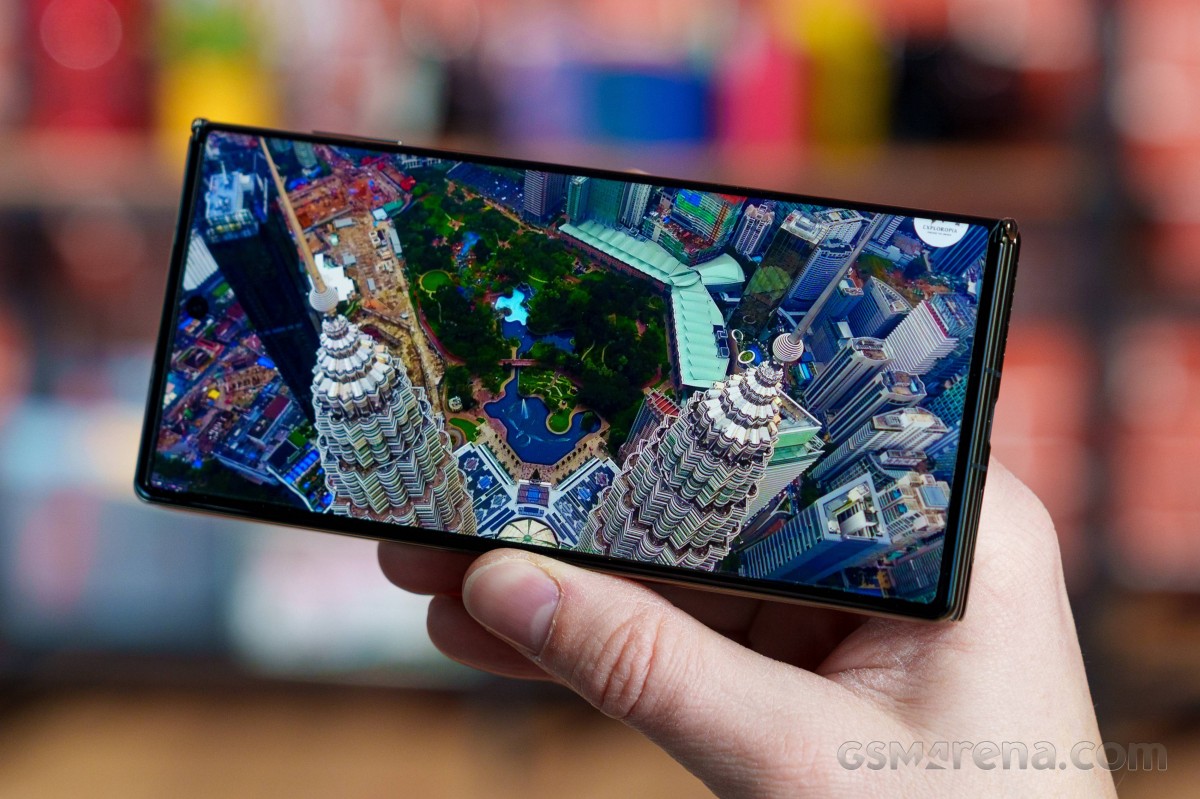
The screen supports HDR10, but it is doubtful it will be recognized across western apps.
In our brightness testing, the XT Ultimate returned okay results. The maximum manual brightness we measured in tablet mode was 568 nits and the maximum automatic brightness was 944 nits. In smartphone mode, the screen offers similar performance - 575 nits for manual and 939 nits for automatic brightness.
The minimum brightness was 2.1 nits.
Max display brightness test
White test pattern, 75% fill (nits)Manual mode
Auto mode
 Pixel 9 Pro Fold (Cover display)
Pixel 9 Pro Fold (Cover display)
2199
6.3" OLED1080 x 2424 px
 vivo X Fold3 Pro (Cover display)
vivo X Fold3 Pro (Cover display)
1835
6.53" AMOLED1172 x 2748 px
 Galaxy Z Fold6
Galaxy Z Fold6
1630
7.6" Foldable Dynamic LTPO AMOLED 2X1856 x 2160 px
 Galaxy Z Fold6 (Cover display)
Galaxy Z Fold6 (Cover display)
1559
6.3" Dynamic LTPO AMOLED 2X968 x 2376 px
 Xiaomi Mix Fold 3
Xiaomi Mix Fold 3
1277
8.03" Foldable LTPO OLED+1916 x 2160 px
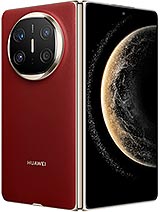 Huawei Mate X6
Huawei Mate X6
1173
7.93" Foldable LTPO OLED2240 x 2440 px
 Xiaomi Mix Fold 3 (Cover display)
Xiaomi Mix Fold 3 (Cover display)
1165
6.56" AMOLED1080 x 2520 px
 Huawei Mate X6 (Cover display)
Huawei Mate X6 (Cover display)
1143
7.93" Foldable LTPO OLED2240 x 2440 px
 Huawei Mate XT Ultimate
Huawei Mate XT Ultimate
944
6.40" OLED1008 x 2232 px
 Huawei Mate XT Ultimate (folded)
Huawei Mate XT Ultimate (folded)
939
6.40" OLED1008 x 2232 px
The screen supports dynamic refresh rate up to 90Hz, but the integrated refresh rate counter is not working properly, so we cannot confirm the exact steps it can offer. The available options in Settings are High (up to 90Hz with using the maximum possible RR), Standard (up to 60Hz), and Dynamic (up to 90Hz, but smart switching for longer battery life).
The Mate XT Ultimate display supports HDR Vivid, which improves on HDR10 by using dynamic metadata to adjust brightness, contrast, and color levels on a scene-by-scene or frame-by-frame basis. In comparison, HDR10 uses static metadata, which is constant for the entire video. HDR Vivid is similar to Dolby Vision, but it is an open format unlike Dolby Vision.
ADVERTISEMENT

In our testing, some apps detect the screen as HDR10-capable, but since the Mate XT Ultimate only supports Widevine L3 DRM, you will not get HDR or high-res streaming from any online service.
But if you use those apps via the GBox virtual machine, you may get maximum resolution and HDR10 streaming after all. This applies to Netflix and YouTube, too. Of course, that would depend on the smartphone model that Gbox chooses to emulate.
Another interesting bit is that Huawei does its HDR video playback just like Apple - meaning in a very flexible way. It's not necessary for the content to be displayed full-screen for HDR to work. It can just work on the portion of the display that has the video playing, which is a bit of an odd experience the first couple of times you encounter it.
Battery life
The Huawei Mate XT Ultimate is powered by a large 5,600mAh battery with a Si/C anode. It's made up of three parts, each thinner than 2mm, distributed in the different sections of the device.
The Mate XT Ultimate returned a rather uninspiring Active Use Score of 7:48h for its 10.2-inch display - you could call it poor, even. Then again, this is essentially a tablet with a smartphone-sized battery, so perhaps some perspective adjustment is necessary.


Huawei Mate XT Ultimate
7:48h
Active use score
:3008h
:630h
:1024h
:418h
GSMArena mix
20%
30%
30%
20%
Calls
Web
Video
Game
Battery tests automated via the viSer app by
 Huawei
Huawei
Mate XT Ultimate
5600 mAh
7:48h30:08h6:30h10:24h4:18h
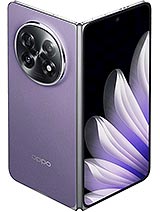 Oppo
Oppo
Find N5
5600 mAh
13:16h39:40h11:45h15:07h8:00h❌︎
 Samsung
Samsung
Galaxy Z Fold6
4400 mAh
11:31h28:28h9:22h14:58h7:12h❌︎
 vivo
vivo
X Fold3 Pro
5700 mAh
13:26h28:11h12:41h16:22h7:53h❌︎
 Huawei
Huawei
Mate X6
5110 mAh
8:56h20:11h7:16h13:53h5:07h❌︎
 Honor
Honor
Magic V3
5150 mAh
10:05h29:47h8:39h12:19h5:59h❌︎
Active use score
Add to comparison
When used completely folded, on a 6.4-inch cover screen, the Mate XT posted an 11:56h Active Use Score with good web, video streaming, and gaming times. We've seen better, sure, but we will take it.
 Huawei
Huawei
Huawei Mate XT Ultimate
5600 mAh
11:56h30:08h9:39h14:17h7:59h
 Huawei
Huawei
Mate X6
5110 mAh
11:26h20:11h9:07h16:42h7:30h
 Honor
Honor
Magic V3
5150 mAh
13:21h29:47h11:08h14:47h8:13h
 Samsung
Samsung
Galaxy Z Fold6
4400 mAh
13:01h28:28h10:24h16:53h8:43h
 Oppo
Oppo
Find N5
5600 mAh
15:49h39:40h11:58h20:53h10:39h
Active use score
Charging speed
The Huawei Mate XT Ultimate supports Huawei's 66W SuperCharge and 50W Wireless SuperCharge. The retail bundle of the global model contains a proprietary 6A-rated USB cable, but no charger. The phone also supports reverse wireless charging up to 7.5W.
We've used an Honor 66W SuperCharge power adapter we've had lying around for the purpose of our charge speed test.
This 66W adapter and the bundled cable got us to 45% in 15 minutes, and the battery indicator was showing 78% at the 30-minute mark. A full charge took 60 minutes. This surely isn't the fastest possible charging, but plenty fast enough.
Note that the charging speed may drop by 50% if you charge the phone closed as an overheating prevention measure. Huawei suggests recharging the Mate XT unfolded for faster speed and longer battery lifespan.
Charging speedin 15 min
in 30 min
Time to full charge (from 0%)
 Huawei Mate X6
Huawei Mate X6
83%
5110 mAh66W Huawei SuperCharge
 Honor Magic V3
Honor Magic V3
82%
5150 mAh66W Honor SuperCharge
 vivo X Fold3 Pro
vivo X Fold3 Pro
79%
5700 mAh120W FlashCharge
 Huawei Mate XT Ultimate
Huawei Mate XT Ultimate
78%
5600 mAh66W
 Oppo Find N5
Oppo Find N5
72%
5600 mAh80W SuperVOOC
 Xiaomi Mix Fold 3
Xiaomi Mix Fold 3
70%
4800 mAhXiaomi 67W
 Galaxy Z Fold6
Galaxy Z Fold6
49%
4400 mAh25W Samsung PD
 Pixel 9 Pro Fold
Pixel 9 Pro Fold
46%
4650 mAh21W PD 3.0
The Mate XT Ultimate supports Smart Charge, which learns about your charging habits and drops the charging speed once it reaches 80%, only to complete the charging closer to your expected waking time if you are doing an overnight charging. Or you can set the maximum charge limit instead of slowing the charging speed - it could be 70%, 80%, or 90% (or the full 100%, of course).
Speakers
The large Huawei Mate XT has only two speakers - one at the top and another at the bottom. The stereo setup is symmetrical when the phone is in the closed position and sort of diagonally opposed (top left - bottom right) when using it open.
We would have expected four speakers for this foldable tablet and we were a bit disappointed to find out there are only two.
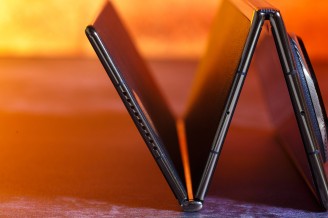
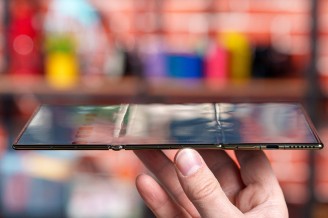
Top speaker • Bottom speaker
While the speakers of the Mate XT offer rich sound with a balanced presentation, they turned out quiet and scored an Average mark on our loudness test. That said, the Find N5 with a very similar integrated loudness results just barely made it into the 'Good' category, so it's not a day and night type of difference.
The XT Ultimate does sound nicer to our ears than its X6 brother, though both the vivo X Fold3 Pro and the Galaxy Z Fold6 deliver superior output.

0:00/5:16
Song 1
Song 2
Song 3
Song 4
Song 5
Song 6
Song 7
 Huawei
Huawei
Mate XT Ultimate-28.1 LUFSAverageloudness score
 Oppo
Oppo
Find N5-28.0 LUFSGoodloudness score❌︎
 Samsung
Samsung
Galaxy Z Fold6-26.5 LUFSGoodloudness score❌︎
 vivo
vivo
X Fold3 Pro-27.8 LUFSGoodloudness score❌︎
 Huawei
Huawei
Mate X6-27.3 LUFSGoodloudness score❌︎
 Honor
Honor
Magic V3-28.3 LUFSAverageloudness score❌︎
Add to comparison
Speaker frequency responseHuawei Mate XT Ultim…Oppo Find N5Samsung Galaxy Z Fol…1/250Hz100Hz500Hz1000Hz5000Hz10000Hz-30dB-20dB-10dB0dB10dB20dB30dB
XHuawei Mate XT UltimateOppo Find N5Samsung Galaxy Z Fold6vivo X Fold3 ProHuawei Mate X6Honor Magic V327.258 -21.53 -24.049 -28.521 -26.766 -17.832 -28.994
44.348 -12.602 -23.329 -27.769 -25.008 -11.416 -26.994
65.574 -9.316 -21.641 -27.409 -20.981 -11.592 -21.579
91.616 -15.351 -14.972 -17.364 -17.022 -18.998 -16.581
123.122 -11.953 -9.781 -9.62 -14.783 -13.04 -10.296
160.746 -6.786 -6.13 -6.296 -11.363 -7.595 -4.463
205.164 -1.709 -3.68 -2.655 -7.619 -2.833 -2.415
257.068 -4.365 -8.259 -3.108 -5.91 -6.882 -3.626
317.168 -8.62 -10.125 -4.864 -8.412 -11.057 0.767
386.189 -5.542 -8.038 0.673 -3.487 -7.453 -6.227
464.863 -9.325 -13.558 -7.408 -10.671 -13.138 -9.855
553.931 -9.072 -11.28 -13.23 -8.757 -12.016 -10.039
654.134 -9.105 -5.554 -19.266 -5.072 -13.036 -4.582
766.209 -5.589 -4.385 -14.245 -3.582 -12.342 -9.503
890.88 -1.844 -5.698 -10.976 -8.159 -7.505 -9.703
1,028.86 0.649 -4.105 -7.43 -9.056 -5.229 -8.755
1,180.84 2.866 -3.212 -2.86 -6.324 -7.347 -2.48
1,347.49 0.103 0.994 -0.508 -2.143 -4.662 3.634
1,529.42 -2.24 4.382 3.584 4.017 2.748 5.826
1,727.23 -1.611 6.235 5.401 7.309 7.146 8.229
1,941.47 -4.055 8.678 6.522 8.534 11.104 3.767
2,172.62 -1.401 10.582 10.223 11.399 15.833 4.426
2,421.12 4.458 6.919 12.787 12.809 15.714 14.785
2,687.33 6.422 8.011 13.46 10.588 14.037 16.942
2,971.55 10.197 13.553 17.484 14.26 17.373 16.981
3,274.01 10.519 12.695 18.579 17.383 17.252 15.443
3,594.84 11.109 10.945 14.791 16.849 14.773 9.336
3,934.11 13.759 9.182 11.816 17.924 11.921 9.569
4,291.77 15.005 9.385 9.103 16.873 8.787 12.846
4,667.69 16.017 13.133 11.207 17.706 11.06 11.664
5,061.66 16.276 15.621 14.379 17.888 15.307 8.591
5,473.35 16.029 12.254 13.066 15.005 15.454 4.848
5,902.32 15.001 7.356 10.857 11.737 12.968 3.524
6,348.04 13.916 7.042 8.025 8.65 10.82 4.939
6,809.87 12.491 9.888 5.93 7.189 11.819 7.266
7,287.07 10.503 10.778 4.246 6.507 13.152 9.092
7,778.78 8.691 12.738 4.557 6.912 13.399 8.041
8,284.06 9.631 15.221 7.331 8.791 15.219 5.403
8,801.83 12.765 15.039 10.611 11.377 17.901 4.049
9,330.94 15.051 12.541 11.647 11.509 19.871 2.84
9,870.15 15.702 10.224 11.873 10.183 18.832 0.133
10,418.1 13.755 9.583 11.284 10.265 16.181 -4.086
10,973.3 10.031 8.474 9.69 10.771 13.452 -5.469
11,534.4 6.388 6.79 7.3 11.109 12.194 -5.023
12,099.6 4.52 5.095 4.105 11.736 11.086 -4.623
12,667.3 2.807 2.998 1.179 10.892 8.815 -4.375
13,235.9 0.924 -0.964 -0.709 9.942 5.534 -6.06
13,803.4 -2.417 -5.203 -2.851 8.889 1.555 -8.971
14,368.2 -7.134 -8.24 -5.658 5.628 -2.511 -11.916
14,928.3 -10.974 -9.968 -7.992 1.042 -5.358 -14.83
15,481.8 -13.502 -10.772 -10.334 -3.675 -7.783 -17.305
16,026.8 -15.339 -11.292 -13.177 -8.746 -10.513 -18.836
16,561.4 -16.482 -12.393 -15.42 -13.249 -12.735 -19.473
17,083.7 -17.128 -14.02 -16.995 -16.328 -14.255 -19.648
17,591.8 -17.668 -15.67 -18.345 -18.123 -15.317 -19.615
18,083.7 -18.029 -16.906 -19.543 -19.186 -16.007 -19.551
18,557.8 -18.338 -17.721 -20.346 -19.663 -16.235 -19.47
19,012 -18.54 -18.22 -20.758 -19.767 -16.234 -19.392
19,444.8 -18.666 -18.449 -21.08 -19.743 -16.147 -19.349
19,854.4 -18.775 -18.465 -21.361 -19.7 -16.004 -19.338
Use the Playback controls to listen to the phone sample recordings (best use headphones). We measure the average loudness of the speakers in LUFS. A lower absolute value means a louder sound. A look at the frequency response chart will tell you how far off the ideal "0db" flat line is the reproduction of the bass, treble, and mid frequencies. You can add more phones to compare how they differ. The scores and ratings are not comparable with our older loudspeaker test. Learn more about how we test here.
EMUI 14.2
The Huawei Mate XT Ultimate boots EMUI 14.2 on the global variant and Harmony OS 4.2 in China. This is one version below the latest available software from the company - EMUI 14.3 and Harmony OS 4.3, which is odd.
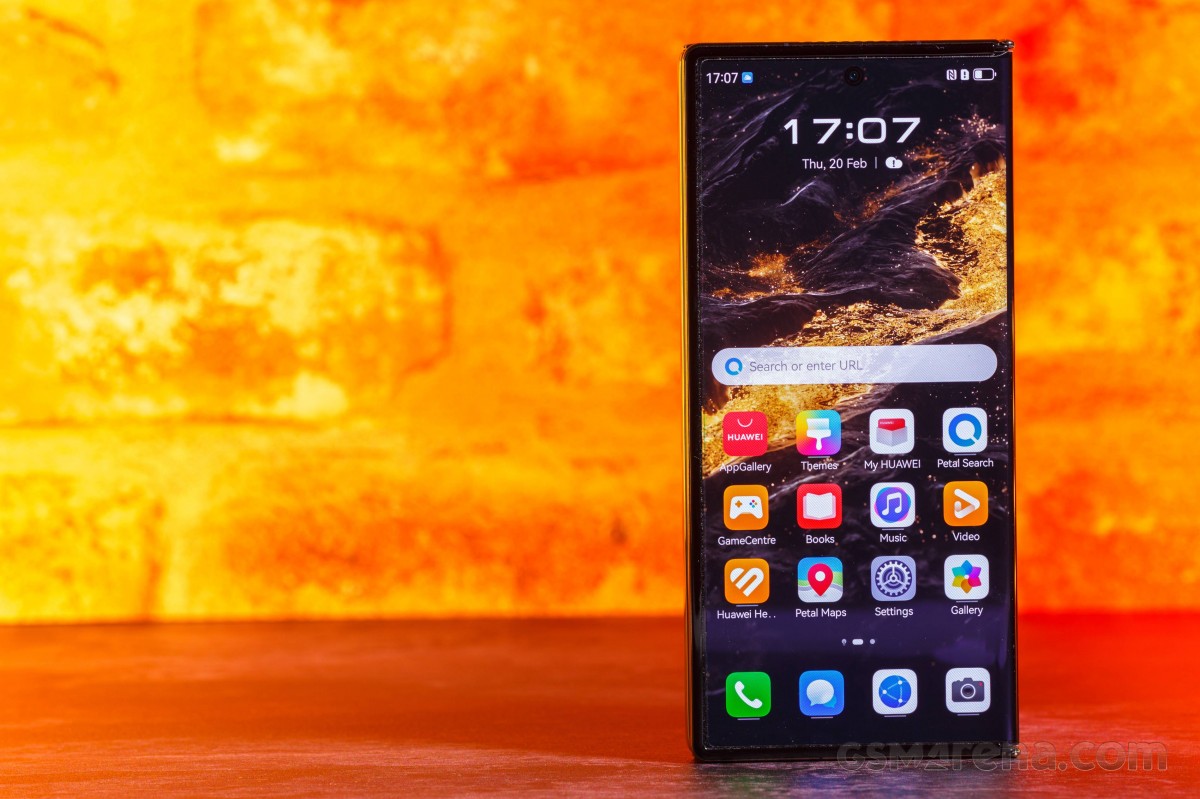
The global EMUI 14.2 includes an Android 12 core inside. The OS still supports APK installations via Huawei's AppGallery, APK Pure, or similar, and the Gbox app or microG app will let you download apps from the Google Play Store too.
EMUI looks quite familiar as it has not changed drastically over the years. It includes neat little things like large folders and cards - another name for the widgets that you can add for in-house apps, indicated by a bar under the app icon.
Air gestures and smart sensing are supported on the Mate XT - a familiar capability also found on previous Huawei models.

Huawei offers a lot of default apps to get you started. There is Huawei's Gallery, Music, Video, and Health apps. A File Manager app is available, as well.
There is also Smart Remote - you can turn your phone into a universal remote thanks to its IR blaster.
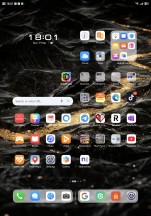
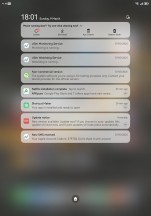
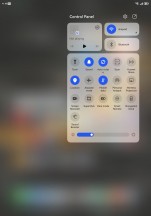
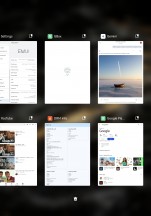
EMUI 14
You also get Petal Maps, Petal Search, and Huawei's own Browser.
Finally, let's talk about multi-tasking. Naturally, the big screen offers a lot more estate for work and play. EMUI 14 has a great multi-window implementation with intuitive actions and both horizontal and vertical splits with a relatively wide ratio adjustment range (not just 50/50), plus floating windows.



Multi-tasking
Transitions between the 1/3, 2/3 and 3/3 screen options are smooth and hassle-free.
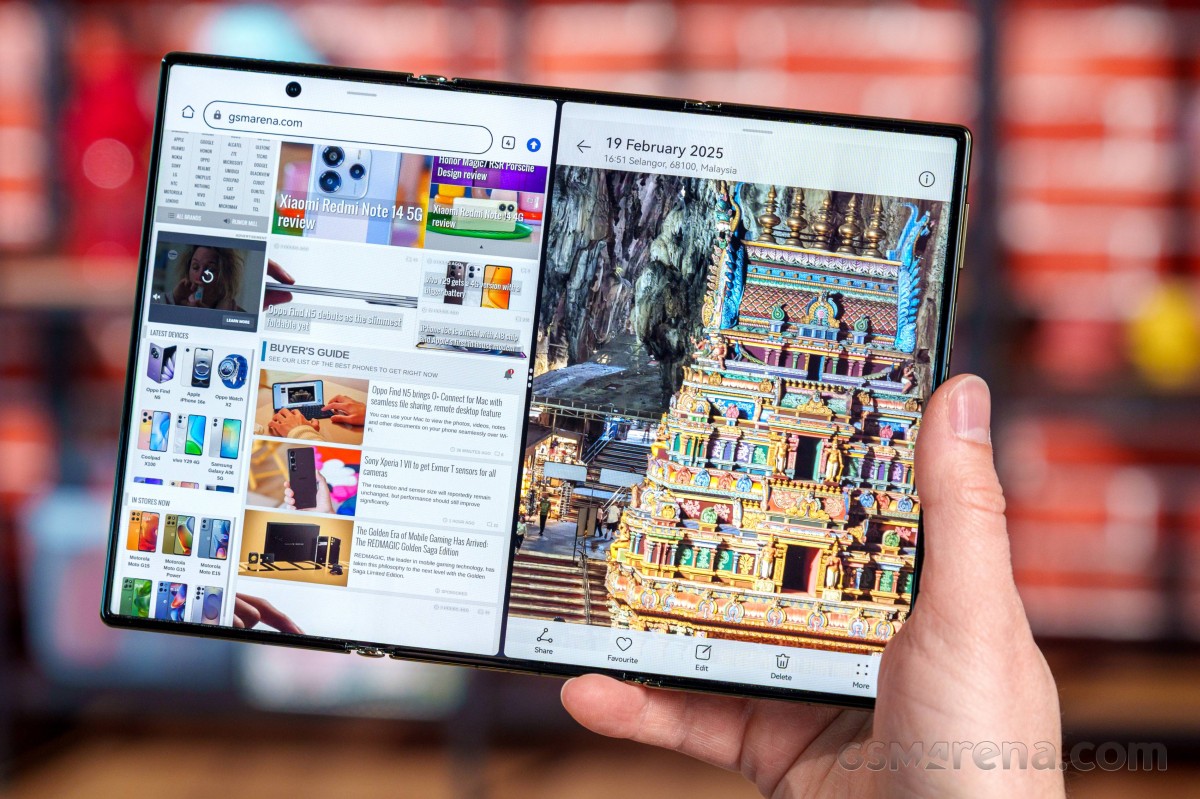
As for AI features, you will find the usual Smart Remove feature in the image gallery editor (but it may not as smart as on other phones).


Smart Remove
Note that we were able to use Google Gemini without any issues on this phone, so you get access to Google's generative AI tool too.

Gemini
There is also AI Noise Cancellation during calls to intelligently filter out surrounding noise to ensure your voice comes through crystal-clear to the other side.
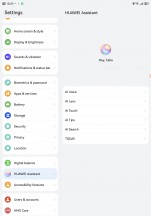


Some smart functions
Huawei's AppGallery handles the app installations by default, and it still includes advertisements and pop-ups, but it was less intrusive this time around than on previous encounters.
You can install other app repositories too, and they work just fine.
The best solution for making most of the Google-dependent apps working on the Mate XT is GBox. It's a small virtual machine based on the latest Android version, and it contains all Google services. You have a list of apps you can install right away, but you can also install extra apps from the integrated Play Store. Updates via the Google Play Store are also possible.
ADVERTISEMENT

The GBox creates app shortcuts on your homescreen. Notifications are supported, of course. We had no issues running Google Maps, Google Drive, Chrome, or YouTube. Google Gemini works just fine, too.
Video streaming quality will also be limited by what the GBox emulation layer supports, but as we established 1080p+ HDR10 streams are available on YouTube and Netflix.
Performance and benchmarks
The Huawei Mate XT is powered by Huawei's Kirin 9010 chipset. This is not the maker's latest chip as seen on the Mate X6 (Kirin 9020), which we find a little odd. It might explain the lack of a 120Hz refresh rate.
Anyway, the Kirin 9010 packs an 8-core CPU - 1x2.3GHz Taishan Big + 3x2.18GHz Taishan Mid + 4x1.55GHz Cortex-A510 cores. It is manufactured on an SMIC 7nm node, known as N+2 locally in China, like the Kirin 9000s inside the Mate 60 series. It also contains the HiSilicon Maleoon 910 MP4 GPU.
Huawei Mate XT Ultimate comes with 16GB LPDDR5X RAM and 256GB, 512GB, or 1TB of UFS storage. The global version is the one with 1TB storage (as reviewed).
And now, let's see some benchmark scores.
Quite expectedly, the Mate XT offers mid-range performance at best, and it is behind the Mate X6 because the XT's chipset is a generation behind.
GeekBench 6Multi-core
Single-core
 Oppo Find N5
Oppo Find N5
8146
Snapdragon 8 Elite512GB, 16GB RAM
 vivo X Fold3 Pro
vivo X Fold3 Pro
6791
Snapdragon 8 Gen 3512GB, 16GB RAM
 Galaxy Z Fold6
Galaxy Z Fold6
6757
Snapdragon 8 Gen 3 SM8650-AC512GB, 12GB RAM
 Honor Magic V3
Honor Magic V3
6461
Snapdragon 8 Gen 3512GB, 12GB RAM
 Xiaomi Mix Fold 3
Xiaomi Mix Fold 3
5296
Snapdragon 8 Gen 2 SM8550-AC512GB, 16GB RAM
 Huawei Mate X6
Huawei Mate X6
5218
Kirin 9020512GB, 12GB RAM
 Honor Magic V2
Honor Magic V2
4959
Snapdragon 8 Gen 2512GB, 16GB RAM
 Pixel 9 Pro Fold
Pixel 9 Pro Fold
4783
Google Tensor G4256GB, 16GB RAM
 Huawei Mate XT Ultimate
Huawei Mate XT Ultimate
3763
Kirin 90101TB, 16GB RAM
AnTuTu 10
 vivo X Fold3 Pro
vivo X Fold3 Pro
2066322
Snapdragon 8 Gen 3512GB, 16GB RAM2200 x 2480 px
 Oppo Find N5
Oppo Find N5
1952065
Snapdragon 8 Elite512GB, 16GB RAM2248 x 2480 px
 Galaxy Z Fold6
Galaxy Z Fold6
1608744
Snapdragon 8 Gen 3 SM8650-AC512GB, 12GB RAM1856 x 2160 px
 Honor Magic V3
Honor Magic V3
1589991
Snapdragon 8 Gen 3512GB, 12GB RAM2156 x 2344 px
 Honor Magic V2
Honor Magic V2
1551239
Snapdragon 8 Gen 2512GB, 16GB RAM2156 x 2344 px
 Xiaomi Mix Fold 3
Xiaomi Mix Fold 3
1527952
Snapdragon 8 Gen 2 SM8550-AC512GB, 16GB RAM1916 x 2160 px
 Huawei Mate X6
Huawei Mate X6
1298127
Kirin 9020512GB, 12GB RAM2240 x 2440 px
 Pixel 9 Pro Fold
Pixel 9 Pro Fold
1222228
Google Tensor G4256GB, 16GB RAM2076 x 2152 px
 Huawei Mate XT Ultimate
Huawei Mate XT Ultimate
873240
Kirin 90101TB, 16GB RAM1008 x 2232 px
3DMark - Wild Life Extreme (2160p)
 Oppo Find N5
Oppo Find N5
5987
Snapdragon 8 EliteAdreno 8302248 x 2480 px
 Honor Magic V3
Honor Magic V3
4759
Snapdragon 8 Gen 3Adreno 7502156 x 2344 px
 vivo X Fold3 Pro
vivo X Fold3 Pro
4714
Snapdragon 8 Gen 3Adreno 7502200 x 2480 px
 Galaxy Z Fold6
Galaxy Z Fold6
4644
Snapdragon 8 Gen 3 SM8650-ACAdreno 7501856 x 2160 px
 Xiaomi Mix Fold 3
Xiaomi Mix Fold 3
3794
Snapdragon 8 Gen 2 SM8550-ACAdreno 7401916 x 2160 px
 Honor Magic V2
Honor Magic V2
3732
Snapdragon 8 Gen 2Adreno 7402156 x 2344 px
 Pixel 9 Pro Fold
Pixel 9 Pro Fold
2620
Google Tensor G4Mali-G715 MC72076 x 2152 px
 Huawei Mate X6
Huawei Mate X6
1907
Kirin 9020Maleoon 9202240 x 2440 px
 Huawei Mate XT Ultimate
Huawei Mate XT Ultimate
1401
Kirin 9010Maleoon 9101008 x 2232 px
The CPU throttle test was incompatible with this version of EMUI, so we couldn't run it. But if the Pura 70 Ultra delivered 57% sustained performance, we will expect something in this ballpark, maybe a little lower.
The mid-range GPU offers 99% sustained performance in a completely unfolded state and 58% in completely folded mode.
The Huawei Mate XT Ultimate may be one of the most expensive smartphones out there, but it's definitely the slowest flagship to date. Huawei is still quite behind the competition in terms of chip making and it will take years to catch up with the likes of Qualcomm and Apple. The performance is enough for day-to-day operation, office tasks, and multimedia, but the gaming experience will be rather mediocre.
Tri-fold with nice cameras - why not?
Foldables are often challenged in the camera department, as makers try to balance weight, volume, cost, and image quality - somehow image quality always tends to suffer. Huawei, on the other hand, has a history of being above the rest in camera hardware on its bendy phones, but then the Mate XT Ultimate is unlike all other bendy phones in terms of, well, weight, volume, and cost, so it's several layers of complicated.

Despite all space constraints, the XT Ultimate comes with the same main camera as the X6 - a reasonably-sized 1/1.56" sensor (especially for a foldable) coupled with a vari-aperture lens (f/1.4-f/4.0).
The X6's ultrawide didn't make the cut, so instead of a 40MP sensor, the XT Ultimate has a 12MP one (more like 12.6MP, but Huawei insists on 12MP in official specs).
Then there's the telephoto. It's got a periscope lens that has an equivalent focal length of 125mm as per the company's own data, and that's how it's reported in hardware apps, making for an almost perfect 5x zoom from the 24mm main camera. The thing is, both the XT Ultimate promo materials and the viewfinder state 5.5x zoom and the EXIF data from images captured on it does report 132mm. Huawei is no stranger to doing weird things with native vs. resultant focal lengths - 23mm main cameras that captured 27mm images were a thing for a while, so the 5x-5.5x discrepancy doesn't exactly surprise us.
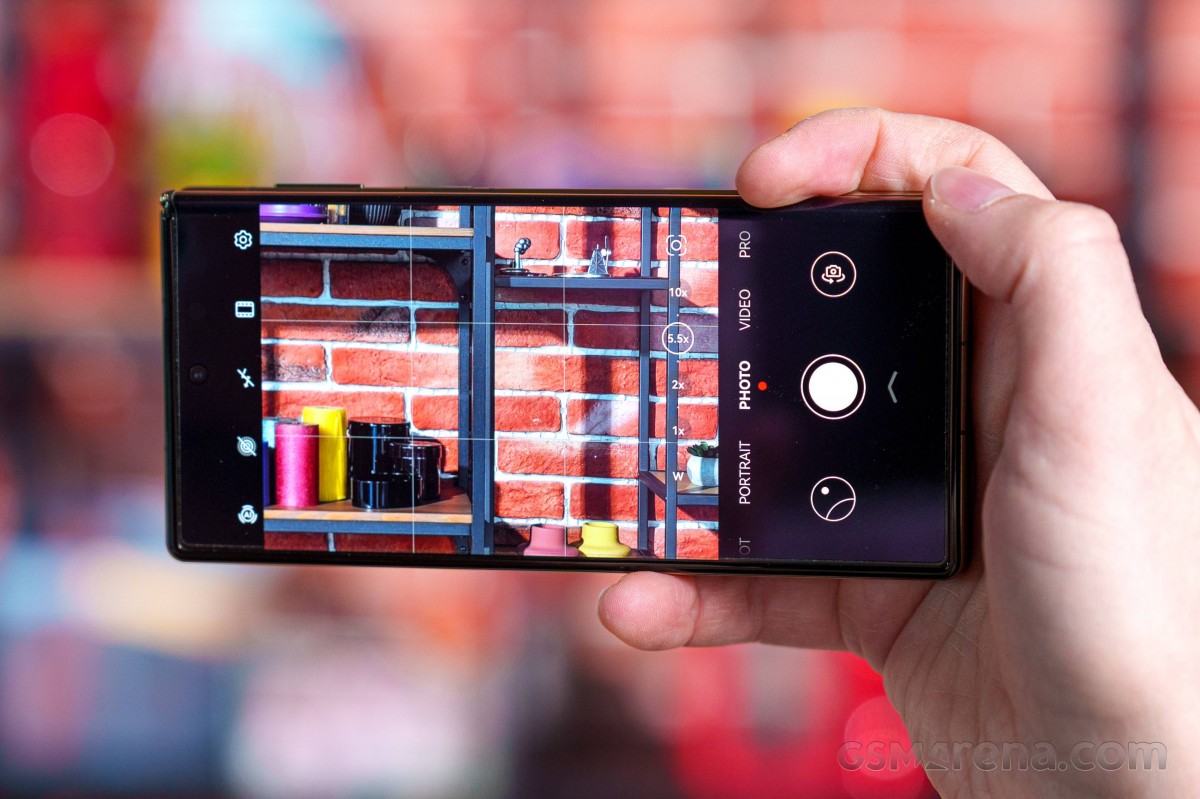
The selfie camera - the one in the leftmost/topmost third of the display - is an 8MP f/2.2 unit with fixed focus. This one says 19mm in hardware apps and 23mm in EXIF and the latter is a lot more believable.Wide (main): 50MP (1/1.56", 1.0µm - 2.0µm), f/1.4-f/4.0, 24mm, PDAF, Laser AF, OIS; 4K@60fps
Ultrawide: 12MP (1/2.9", 1.24µm), f/2.2, 13mm, PDAF; 4K@60fps
Telephoto, 5.5x: 12MP (1/3.6", 1.0µm), f/3.4, 125/132mm, PDAF (80cm - ∞), OIS; 4K@60fps
Front camera: 8MP (1/3.6", 1.22µm), f/2.2, 19/23mm, fixed focus; 4K@30fps
Daylight photo quality
Main camera
The Mate XT Ultimate captures great-looking photos with its main camera at 1x. They're packed with detail, which has a particularly fine quality to it albeit with the occasional case of jaggies and some slightly oddly rendered grass. Noise is non-existent. Contrast is on the high side of average, though we wouldn't say dynamic range is limited because of it - it's just a specific look. White balance is typically accurate while color saturation is slightly conservative, but nowhere near lifeless.











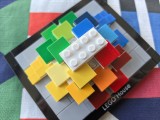
Daylight samples, main camera (1x)
People shots aren't half bad either, with great facial detail and nice skin tones. Portrait mode works well too.




Daylight samples, main camera (1x), Photo mode




Daylight samples, main camera (1x), Portrait mode
There are two different flavors of 50MP photos on the Mate - an AI-labeled one and a plain one. The AI version can be properly impressive, managing to capture finer detail in certain scenes and types of subject matter (or it makes it up, but in a convincing way). The downside is that it takes 3s to capture.
The regular 50MP shots aren't nearly as good - they're soft and noisy, and have a washed out quality to them.




Daylight samples, main camera (1x), 50MP, AI




Daylight samples, main camera (1x), 50MP, no AI
The 2x shots are also properly nice, with excellent detail and no signs of upscaling or overprocessing - it's as if the phone has a dedicated 2x camera.








Daylight samples, main camera (2x)
That excellence extends to photos of people, which maintain great detail. The 50-ish millimeter focal length is better for facial proportions, and here you don't have to sacrifice any quality to reap those benefits.




Daylight samples, main camera (2x), Photo mode




Daylight samples, main camera (2x), Portrait mode
There's no shortcut to 3x in the Photo mode viewfinder, but there is a 3x Portrait mode (72mm equivalent). It too is looking very good, with only a minor drop in pixel-level quality.




Daylight samples, main camera (3x), Portrait mode
Telephoto camera, 5.5x
The Mate XT Ultimate's telephoto camera takes pretty solid shots at 5.5x (or, again, 5x, depending on how you look at it). Detail is good, if not necessarily the finest and most natural rendition, and there's no noise. Contrast is pretty high again, but the tonal extremes are handled well. Colors are generally very good too. The one sort of major issue is close focusing - with a minimum focus distance of 80cm (with some coercing) this tele is better suited to distant subjects.











Daylight samples, telephoto camera (5.5x)
Shooting head-and-shoulder portraits will get you comfortably far from your subject for the phone to focus on them (if a bit too far from them generally). We'd say these are excellent quality shots, and the lack of a Portrait mode at this zoom level isn't strictly an omission you're going to feel.




Daylight samples, telephoto camera (5.5x), Photo mode
There's one extra zoom level in the viewfinder - it's 10x, and not 11x, adding an extra layer of weirdness to the zoom implementation. Or is the 10x a return to normalcy if we assume that 5x was the 'native' magnification? We digress. The results aren't exactly great on a pixel level, but will do for... certain applications.




Daylight samples, telephoto camera (10x)
Ultrawide camera
The ultrawide camera's coverage is pretty extreme, making its corner-to-corner sharpness all the more praiseworthy. Dynamic range is very good (pretty high contrast again) and colors are a bit more vivid than on the main camera, which is sort of welcome. An overall great showing here.












Daylight samples, ultrawide camera
Selfies
Selfies taken in the fully folded state, on the 8MP in-display camera, are surprisingly nice, both in terms of detail and color rendition.




Selfie samples, 'cover' camera
Still, it would pay off to do some finger gymnastics and unfold the Ultimate halfway, so that you have both the rear cameras and a portion of the display facing towards you. The 1x main camera's selfies are superb, and you can also use the ultrawide for weirder perspectives or to capture more of your surroundings.




Selfie samples, main camera




Selfie samples, ultrawide camera
Low-light photo quality
Main camera
In the dark, the Mate's main camera does a good job at 1x. It produces balanced exposures with great dynamic range. Detail is generally very good too, but shadows in some darker scenes can end up softer than ideal. Colors are typically on point, with dependable white balance and good saturation.








Low-light samples, main camera (1x)
We had established a policy of not doing dedicated Night mode comparisons, because phones seemed to have moved past needing that, but we figured that the Mate's... occasional missteps in Photo mode and the device's overall uniqueness warranted going the extra distance.
Night mode does crank up the sharpening and introduces some of that watercolor effect, but it's not the worst offender. A notable positive outcome is the livening up of the shadows and lower midtones, and that can also add some extra pop to colors. We'd say it's a sensible trade-off and it can be worth it in certain scenes. The 3s that each shot takes feels like a bit of drag though, and we had some shot-to-shot variation with white balance (minor, but often).






Low-light samples, main camera (1x), Night mode
At 2x zoom, things aren't as impressive in the dark as they were during the day. Shadows are typically quite soft, though the better lit areas in the same photo can be looking pretty good at the same time. Night mode doesn't really do a lot to help here - it may boost shadows and color, but shots get softer overall.








Low-light samples, main camera (2x)




Low-light samples, main camera (2x), Night mode
Telephoto camera, 5.5x
You shouldn't expect standout photo quality from the zoom camera at night - the images alright, but not more than that. Detail is decent in the well-lit areas and notably softer in the shadows. Dynamic range and colors are pretty good though.








Low-light samples, telephoto camera (5.5x)
Night mode can actually be quite beneficial on the telephoto, boosting detail and definition across the board - shadows and well-lit patches alike. You should probably just default to that when using the zoom camera in the dark.






Low-light samples, telephoto camera (5.5x), Night mode
At 10x, detail is pretty sketchy, Photo mode or Night mode.




Low-light samples, telephoto camera (10x)




Low-light samples, telephoto camera (10x), Night mode
Ultrawide camera
The ultrawide camera of the Mate XT Ultimate does decently in the dark. Shadows are on the soft side and colors can be a little muted, but dynamic range is quite good.







Low-light samples, ultrawide camera
Night mode gives exposures a nudge, delivering a boost to shadows and color saturation, but detail doesn't really benefit much.




Low-light samples, ultrawide camera, Night mode
Video recording
The Mate XT Ultimate can record video up to 4K60 with all three of its rear cameras. 4K30 is also an option, of course, but we didn't find a 24fps mode (not in Pro video mode either). There's no 8K capability or 4K120 either (not that these are mandatory or anything). The in-display selfie camera is good for 4K30, which must involve some upscaling, since it doesn't have the pixels for native 4K.
As usual, you get to choose between the h.264 and h.265 codecs. There's also a toggle to enable HDR Vivid recording, the yet another competing HDR standard, backed by Huawei and Mediatek (which is also supported by the handset's display).
ADVERTISEMENT

There's an always-on electronic stabilization, as usual with Huawei smartphones. On top of that, you can also enable the 'Steady shot' mode, which only works on the ultrawide camera, applies a heavy crop, and limits resolution to 1080p (at 30fps or 60fps).
You can check out the playlist below, which includes multiple video samples.
Video sample playlist

Video quality out of the Mate is hard to like. The ultrawide's footage is passable in the context of ultrawides, the main camera's results look like they're coming from an aging midranger, and the telephoto's clips are much too soft. The ultrawide's colors are nice, for what it's worth, and stabilization is generally quite good on both the ultrawide and the main camera (also decent on the telephoto). Things don't magically get better at night and none of the cameras is any good in the dark, all of them delivering results that are way too soft.
Alternative offers
You cannot put a price on innovation and standout design. But Huawei can, and you are not going to like it. The Mate XT Ultimate costs €3,500 for the 16GB/1TB model. Let that sink in.

Huawei advertises the Mate XT Ultimate for its trifold design, exquisite craftsmanship, the immersive high-res display and the Ultra Aperture camera. And those are not empty words, on the contrary, these deliver quality in buckets. It's just that the Mate XT has a mediocre chipset that puts the whole experience in jeopardy.
For future-proofing, any popular foldable phone will fare better. Be it the slim Honor Magic V3 and Oppo Find N5 or the camera-centric vivo X Fold3 Pro - these models have already proven to be excellent offerings.



Honor Magic V3 • Oppo Find N5 • vivo X Fold3 Pro
Our verdict
The Huawei Mate XT Ultimate delivers on what it promises - it's a work of art when it comes to exterior and mechanical design, an immersive trifold screen like nothing you have seen before, and a versatile camera that captures impressive photos (as convertible devices go).
But then comes the mediocre performance, uncertain app future, and lack of Google Mobile Services and a recent Android API support. Plus Huawei has no access to 5G technology outside China. Some of these shortcomings could have been acceptable if the Huawei Mate XT Ultimate did not cost €3,500.

If the eye-watering price tag is not enough to scare you away, then most probably nothing else will - the Huawei Mate XT Ultimate is the only mainstream trifold smartphone right now and if you want such a device, this is it.
But if a trifold is not the point, there is no reason to overspend for this niche product when there are so many excellent foldable offers out there at half the price.
ProsStunning trifold display.
Standout build with an unbelievably thin profile.
Fast wired and wireless charging.
Superb photo quality, great selfies.
Great multi-tasking features.
ConsNo ingress protection.
Mediocre battery life.
Quiet speakers.
Mid-range performance.
No official GMS support, old Android core.
Disappointing video quality.
Super expensive, and yet...
No charger in the box for some markets.
Huawei has been the company to experiment the most with the foldable form factor through the years. It was just recently that we reviewed the Mate X6, one of the thinnest mainstream foldables, and with the Mate XT Ultimate here, Huawei has yet again redefined what a foldable is.

And while the Mate X6 is a foldable phone, the Mate XT Ultimate is more like a foldable tablet! It features a whopping 10.2-inch LTPO OLED screen with 360ppi resolution, 90Hz refresh rate, and 10-bit color depth. This large 16:11 display can be folded one or two times, depending on your preferences and use case.
Huawei has invented two different high-precision hinges for the purposes of the XT design, which are durable yet incredibly thin, and allow the device to remain as thick as a recent Galaxy Z Fold when completely closed. But when it's completely open, this new Mate is only 3.6mm thin!
The Mate XT Ultimate runs on Huawei's own Kirin 9010 - it's a step back from the Kirin 9020, which powers the Mate X6. It's coupled with 16GB RAM and you can get the device with up to 1TB of storage.

Huawei phones have been known for their solid photographic chops and we expect that to be the case with the Mate XT. The rear setup, which can also be used for selfies, has a 50MP primary camera with OIS and a variable aperture, a 12MP 5.5x zoom camera with a periscope telephoto lens, and a 12MP AF ultrawide camera. Laser assistance and a color spectrum sensor complement the back cameras. There is also a small 8MP imager inside a cutout in the screen.
The Mate XT has what appears to be three connected batteries with Si/C composite anode and a total capacity of 5,600mAh. There is 66W wired and 50W wireless charging support, as well as reverse wireless charging.
This innovative foldable tablet boots EMUI 14.2 or Harmony OS 4.2, depending on your region.
Huawei Mate XT Ultimate specs at a glance:Body: 156.7x219.0x4.8mm, 298g; ultra-thin glass, vegan leather back, metal frame.
Display: 10.20" Tri-foldable LTPO OLED, 1B colors, 90Hz, 2232x3184px resolution, 12.84:9 aspect ratio, 381ppi; Cover display (1/3 of the main display): 6.4 inches, 1008 x 2232 pixels, Dual display (2/3 of the main display): 7.9 inches, 2048 x 2232 pixels.
Chipset: Kirin 9010 (7 nm): Octa-core (1x2.3 GHz Taishan Big & 3x2.18 GHz Taishan Mid & 4x1.55 GHz Cortex-A510); Maleoon 910.
Memory: 256GB 16GB RAM, 512GB 16GB RAM, 1TB 16GB RAM.
OS/Software: HarmonyOS 4.2 (China).
Rear camera: Wide (main): 50 MP, f/1.4-f/4.0, 24mm, PDAF, OIS; Telephoto: 12 MP, f/3.4, 125mm, PDAF, OIS, 5.5x optical zoom; Ultra wide angle: 12 MP, f/2.2, 13mm, 120˚, PDAF.
Front camera: 8 MP, f/2.2, (wide).
Video capture: Rear camera: 4K, 1080p, gyro-EIS, OIS, HDR; Front camera: 4K, 1080p.
Battery: 5600mAh; 66W wired, 50W wireless, 7.5W reverse wireless, 5W reverse wired.
Connectivity: 5G; Wi-Fi 6; BT 5.2, L2HC; NFC; Infrared port.
Misc: Fingerprint reader (side-mounted); stereo speakers; BDS Satellite Calling and Messaging - China only.
The Kirin 9010 offers mid-range performance compared to other chipsets and it is limited to 4G connectivity outside China. Another potential setback is the lack of water resistance.
Of course, the biggest omission in the eyes of a Western reader will remain the lack of a newer Android version and Google Mobile Services. While Google apps and services can be installed easily via something like GBox or microG, sooner or later, you will run into an incompatible app there.
Unboxing the Huawei Mate XT Ultimate
The global version of the Mate XT Ultimate arrives in a large box that contains the phone, a USB-C cable and an Aramid Fiber Case with an integrated rotating stand.

This stand certainly comes in handy, especially if you make use of the built-in kickstand, but overall, it's not the most convenient as it has a flap covering the part of the exposed part of the folded screen. The flap gets in the way of conveniently unfolding the screen from a fully closed to a fully unfolded position.
Finally, some markets will also get a 66W power adapter in the retail box so do check with your retailer.
Design, build quality, handling
The Huawei Mate XT Ultimate is like no other smartphone on the market and it is so good to see real innovation for a change. We miss the golden days back when manufacturers weren't afraid of experimenting with phone designs, and we will always appreciate when brands that try something different.

But Huawei did not only try to make the first truly foldable tablet, it succeeded. The device has a proper tablet-level screen size of 10.2 inches but also a proper tablet-grade screen aspect of about 16:11. Those are very iPad-like numbers.

Having such a large screen, trifold at that, would usually mean a thick, bulky device. That's not the case with the Mate XT, though. On the contrary, Huawei has designed this foldable slate to be incredibly thin - just 3.6mm when opened, and 12.8mm when closed. That latter dimension matches the most popular foldable out there - the Galaxy Z Fold6!
 Huawei Mate, Google Fold, and Galaxy Fold
Huawei Mate, Google Fold, and Galaxy FoldThe Huawei Mate XT Ultimate is made of premium materials all-around - there is a super thin rounded metal frame, stainless steel hinges, and a stainless steel camera housing enclosure. The back is covered with either red or black vegan leather, while the tri-fold screen has a layer of ultra-thin glass inside.

The camera housing has been crafted in a very special way, using 80 layers of stainless steel, twisting them, and polishing them. The result is a unique star-shaped piece, that has a different pattern on each phone!

When folded, the Mate XT looks like a thick smartphone with a regular 6.4-inch OLED screen. If you look closely, you can see the small perforation for the 8MP selfie camera, and even a thin earpiece. There is no proximity sensor on the Mate XT - it relies on a software implementation, and it works quite well, we'd say.

You can fold the Mate XT in a way that mimics a regular foldable screen with a 7.9-inch squarish display.

And then, in its fully opened state, Mate XT offers a 10.2-inch OLED screen with a 16:11 aspect ratio. You can notice the usual plastic enclosure around the screen, something that is obvious on any foldable phone. And you should not remove the sort of visible protective film, as this will damage the screen.

The Mate XT is incredibly thin when opened, though in this state, the relatively large camera housing makes it wobble a whole lot.

If you use this large screen estate in portrait mode, the Mate XT feels exactly like a regular-sized tablet, be it an iPad or something else.

The entire back is covered with fingerprint-resistant vegan leather in either black or red.

And then there is a Mate X6-reminiscent camera housing with the twisted pattern we mentioned above. This oversized setup includes a 50MP primary camera with variable aperture, a 12MP 5.5x telephoto, a 12MP ultrawide camera, a laser emitter/receiver combo, a dual-LED flash, and a color spectrum sensor. A microphone is also around.
The top side of the frame has one of the speakers, an IR blaster, and another microphone.
The primary mic, the USB-C port, the SIM bed, and the other speaker are at the bottom.
The Mate XT relies on a side-mounted fingerprint sensor for biometric security, which is not the most comfortable to use in the fully open state, but it is better than nothing.

The Mate XT is an exquisite device, premium and innovative, one that easily stands out no matter the crowd or the situation. And it offers exceptional flexibility and usability; there are no two ways about that.

Prop it up with the bundled case, and its kickstand transforms the Mate XT into a portable monitor or sorts - a great way to watch TV series or YouTube during your lunch break.

The Huawei Mate XT is comfortable to use and secure enough in your hands, no matter how many thirds of the screen you have in operation. We only wish it had some sort of water protection - even a basic IPX4-grade water resistance would have been better than nothing.
A trifold screen like no other
The showstopper on the Huawei Mate XT Ultimate is the 10.2-inch trifold LTPO OLED screen, of course. It's got a 10-bit color depth, 90Hz refresh rate, 240Hz touch sampling, and 1440Hz PWM dimming. In its fully open state, it has a 3,184x2,232px resolution, for an aspect ratio of 16:11(.2), or 1.43:1 if that's how your brain works.

The Mate XT offers three screen sizes. The most impressive one is in tablet mode, obviously - a 10.2-inch diagonal. Then there is a 6.4-inch single screen when folded into smartphone state, and there's an inbetween 7.9-inch dual-pane option when you unlatch one side.
There's a pretty obvious screen crease at each fold, though the two are a little different in feel and appearance. Either one feels like it's a generation or two away from the current batch of Chinese foldables which have minimized their creases to nearly indistinguishable levels. Other than that, we can't find many faults with the screen. It's vivid, bright and the immense diagonal is great for content consumption.

The screen supports HDR10, but it is doubtful it will be recognized across western apps.
In our brightness testing, the XT Ultimate returned okay results. The maximum manual brightness we measured in tablet mode was 568 nits and the maximum automatic brightness was 944 nits. In smartphone mode, the screen offers similar performance - 575 nits for manual and 939 nits for automatic brightness.
The minimum brightness was 2.1 nits.
Max display brightness test
White test pattern, 75% fill (nits)Manual mode
Auto mode
2199
6.3" OLED1080 x 2424 px
 vivo X Fold3 Pro (Cover display)
vivo X Fold3 Pro (Cover display)1835
6.53" AMOLED1172 x 2748 px
 Galaxy Z Fold6
Galaxy Z Fold61630
7.6" Foldable Dynamic LTPO AMOLED 2X1856 x 2160 px
 Galaxy Z Fold6 (Cover display)
Galaxy Z Fold6 (Cover display)1559
6.3" Dynamic LTPO AMOLED 2X968 x 2376 px
 Xiaomi Mix Fold 3
Xiaomi Mix Fold 31277
8.03" Foldable LTPO OLED+1916 x 2160 px
 Huawei Mate X6
Huawei Mate X61173
7.93" Foldable LTPO OLED2240 x 2440 px
 Xiaomi Mix Fold 3 (Cover display)
Xiaomi Mix Fold 3 (Cover display)1165
6.56" AMOLED1080 x 2520 px
 Huawei Mate X6 (Cover display)
Huawei Mate X6 (Cover display)1143
7.93" Foldable LTPO OLED2240 x 2440 px
 Huawei Mate XT Ultimate
Huawei Mate XT Ultimate944
6.40" OLED1008 x 2232 px
 Huawei Mate XT Ultimate (folded)
Huawei Mate XT Ultimate (folded)939
6.40" OLED1008 x 2232 px
The screen supports dynamic refresh rate up to 90Hz, but the integrated refresh rate counter is not working properly, so we cannot confirm the exact steps it can offer. The available options in Settings are High (up to 90Hz with using the maximum possible RR), Standard (up to 60Hz), and Dynamic (up to 90Hz, but smart switching for longer battery life).
The Mate XT Ultimate display supports HDR Vivid, which improves on HDR10 by using dynamic metadata to adjust brightness, contrast, and color levels on a scene-by-scene or frame-by-frame basis. In comparison, HDR10 uses static metadata, which is constant for the entire video. HDR Vivid is similar to Dolby Vision, but it is an open format unlike Dolby Vision.
ADVERTISEMENT

In our testing, some apps detect the screen as HDR10-capable, but since the Mate XT Ultimate only supports Widevine L3 DRM, you will not get HDR or high-res streaming from any online service.
But if you use those apps via the GBox virtual machine, you may get maximum resolution and HDR10 streaming after all. This applies to Netflix and YouTube, too. Of course, that would depend on the smartphone model that Gbox chooses to emulate.
Another interesting bit is that Huawei does its HDR video playback just like Apple - meaning in a very flexible way. It's not necessary for the content to be displayed full-screen for HDR to work. It can just work on the portion of the display that has the video playing, which is a bit of an odd experience the first couple of times you encounter it.
Battery life
The Huawei Mate XT Ultimate is powered by a large 5,600mAh battery with a Si/C anode. It's made up of three parts, each thinner than 2mm, distributed in the different sections of the device.
The Mate XT Ultimate returned a rather uninspiring Active Use Score of 7:48h for its 10.2-inch display - you could call it poor, even. Then again, this is essentially a tablet with a smartphone-sized battery, so perhaps some perspective adjustment is necessary.

Huawei Mate XT Ultimate
7:48h
Active use score
:3008h
:630h
:1024h
:418h
GSMArena mix
20%
30%
30%
20%
Calls
Web
Video
Game
Battery tests automated via the viSer app by

 Huawei
HuaweiMate XT Ultimate
5600 mAh
7:48h30:08h6:30h10:24h4:18h
 Oppo
OppoFind N5
5600 mAh
13:16h39:40h11:45h15:07h8:00h❌︎
 Samsung
SamsungGalaxy Z Fold6
4400 mAh
11:31h28:28h9:22h14:58h7:12h❌︎
 vivo
vivoX Fold3 Pro
5700 mAh
13:26h28:11h12:41h16:22h7:53h❌︎
 Huawei
HuaweiMate X6
5110 mAh
8:56h20:11h7:16h13:53h5:07h❌︎
 Honor
HonorMagic V3
5150 mAh
10:05h29:47h8:39h12:19h5:59h❌︎
Active use score
Add to comparison
When used completely folded, on a 6.4-inch cover screen, the Mate XT posted an 11:56h Active Use Score with good web, video streaming, and gaming times. We've seen better, sure, but we will take it.
 Huawei
HuaweiHuawei Mate XT Ultimate
5600 mAh
11:56h30:08h9:39h14:17h7:59h
 Huawei
HuaweiMate X6
5110 mAh
11:26h20:11h9:07h16:42h7:30h
 Honor
HonorMagic V3
5150 mAh
13:21h29:47h11:08h14:47h8:13h
 Samsung
SamsungGalaxy Z Fold6
4400 mAh
13:01h28:28h10:24h16:53h8:43h
 Oppo
OppoFind N5
5600 mAh
15:49h39:40h11:58h20:53h10:39h
Active use score
Charging speed
The Huawei Mate XT Ultimate supports Huawei's 66W SuperCharge and 50W Wireless SuperCharge. The retail bundle of the global model contains a proprietary 6A-rated USB cable, but no charger. The phone also supports reverse wireless charging up to 7.5W.
We've used an Honor 66W SuperCharge power adapter we've had lying around for the purpose of our charge speed test.
This 66W adapter and the bundled cable got us to 45% in 15 minutes, and the battery indicator was showing 78% at the 30-minute mark. A full charge took 60 minutes. This surely isn't the fastest possible charging, but plenty fast enough.
Note that the charging speed may drop by 50% if you charge the phone closed as an overheating prevention measure. Huawei suggests recharging the Mate XT unfolded for faster speed and longer battery lifespan.
Charging speedin 15 min
in 30 min
Time to full charge (from 0%)
 Huawei Mate X6
Huawei Mate X683%
5110 mAh66W Huawei SuperCharge
 Honor Magic V3
Honor Magic V382%
5150 mAh66W Honor SuperCharge
 vivo X Fold3 Pro
vivo X Fold3 Pro79%
5700 mAh120W FlashCharge
 Huawei Mate XT Ultimate
Huawei Mate XT Ultimate78%
5600 mAh66W
 Oppo Find N5
Oppo Find N572%
5600 mAh80W SuperVOOC
 Xiaomi Mix Fold 3
Xiaomi Mix Fold 370%
4800 mAhXiaomi 67W
 Galaxy Z Fold6
Galaxy Z Fold649%
4400 mAh25W Samsung PD
46%
4650 mAh21W PD 3.0
The Mate XT Ultimate supports Smart Charge, which learns about your charging habits and drops the charging speed once it reaches 80%, only to complete the charging closer to your expected waking time if you are doing an overnight charging. Or you can set the maximum charge limit instead of slowing the charging speed - it could be 70%, 80%, or 90% (or the full 100%, of course).
Speakers
The large Huawei Mate XT has only two speakers - one at the top and another at the bottom. The stereo setup is symmetrical when the phone is in the closed position and sort of diagonally opposed (top left - bottom right) when using it open.
We would have expected four speakers for this foldable tablet and we were a bit disappointed to find out there are only two.


Top speaker • Bottom speaker
While the speakers of the Mate XT offer rich sound with a balanced presentation, they turned out quiet and scored an Average mark on our loudness test. That said, the Find N5 with a very similar integrated loudness results just barely made it into the 'Good' category, so it's not a day and night type of difference.
The XT Ultimate does sound nicer to our ears than its X6 brother, though both the vivo X Fold3 Pro and the Galaxy Z Fold6 deliver superior output.

0:00/5:16
Song 1
Song 2
Song 3
Song 4
Song 5
Song 6
Song 7
 Huawei
HuaweiMate XT Ultimate-28.1 LUFSAverageloudness score
 Oppo
OppoFind N5-28.0 LUFSGoodloudness score❌︎
 Samsung
SamsungGalaxy Z Fold6-26.5 LUFSGoodloudness score❌︎
 vivo
vivoX Fold3 Pro-27.8 LUFSGoodloudness score❌︎
 Huawei
HuaweiMate X6-27.3 LUFSGoodloudness score❌︎
 Honor
HonorMagic V3-28.3 LUFSAverageloudness score❌︎
Add to comparison
Speaker frequency responseHuawei Mate XT Ultim…Oppo Find N5Samsung Galaxy Z Fol…1/250Hz100Hz500Hz1000Hz5000Hz10000Hz-30dB-20dB-10dB0dB10dB20dB30dB
XHuawei Mate XT UltimateOppo Find N5Samsung Galaxy Z Fold6vivo X Fold3 ProHuawei Mate X6Honor Magic V327.258 -21.53 -24.049 -28.521 -26.766 -17.832 -28.994
44.348 -12.602 -23.329 -27.769 -25.008 -11.416 -26.994
65.574 -9.316 -21.641 -27.409 -20.981 -11.592 -21.579
91.616 -15.351 -14.972 -17.364 -17.022 -18.998 -16.581
123.122 -11.953 -9.781 -9.62 -14.783 -13.04 -10.296
160.746 -6.786 -6.13 -6.296 -11.363 -7.595 -4.463
205.164 -1.709 -3.68 -2.655 -7.619 -2.833 -2.415
257.068 -4.365 -8.259 -3.108 -5.91 -6.882 -3.626
317.168 -8.62 -10.125 -4.864 -8.412 -11.057 0.767
386.189 -5.542 -8.038 0.673 -3.487 -7.453 -6.227
464.863 -9.325 -13.558 -7.408 -10.671 -13.138 -9.855
553.931 -9.072 -11.28 -13.23 -8.757 -12.016 -10.039
654.134 -9.105 -5.554 -19.266 -5.072 -13.036 -4.582
766.209 -5.589 -4.385 -14.245 -3.582 -12.342 -9.503
890.88 -1.844 -5.698 -10.976 -8.159 -7.505 -9.703
1,028.86 0.649 -4.105 -7.43 -9.056 -5.229 -8.755
1,180.84 2.866 -3.212 -2.86 -6.324 -7.347 -2.48
1,347.49 0.103 0.994 -0.508 -2.143 -4.662 3.634
1,529.42 -2.24 4.382 3.584 4.017 2.748 5.826
1,727.23 -1.611 6.235 5.401 7.309 7.146 8.229
1,941.47 -4.055 8.678 6.522 8.534 11.104 3.767
2,172.62 -1.401 10.582 10.223 11.399 15.833 4.426
2,421.12 4.458 6.919 12.787 12.809 15.714 14.785
2,687.33 6.422 8.011 13.46 10.588 14.037 16.942
2,971.55 10.197 13.553 17.484 14.26 17.373 16.981
3,274.01 10.519 12.695 18.579 17.383 17.252 15.443
3,594.84 11.109 10.945 14.791 16.849 14.773 9.336
3,934.11 13.759 9.182 11.816 17.924 11.921 9.569
4,291.77 15.005 9.385 9.103 16.873 8.787 12.846
4,667.69 16.017 13.133 11.207 17.706 11.06 11.664
5,061.66 16.276 15.621 14.379 17.888 15.307 8.591
5,473.35 16.029 12.254 13.066 15.005 15.454 4.848
5,902.32 15.001 7.356 10.857 11.737 12.968 3.524
6,348.04 13.916 7.042 8.025 8.65 10.82 4.939
6,809.87 12.491 9.888 5.93 7.189 11.819 7.266
7,287.07 10.503 10.778 4.246 6.507 13.152 9.092
7,778.78 8.691 12.738 4.557 6.912 13.399 8.041
8,284.06 9.631 15.221 7.331 8.791 15.219 5.403
8,801.83 12.765 15.039 10.611 11.377 17.901 4.049
9,330.94 15.051 12.541 11.647 11.509 19.871 2.84
9,870.15 15.702 10.224 11.873 10.183 18.832 0.133
10,418.1 13.755 9.583 11.284 10.265 16.181 -4.086
10,973.3 10.031 8.474 9.69 10.771 13.452 -5.469
11,534.4 6.388 6.79 7.3 11.109 12.194 -5.023
12,099.6 4.52 5.095 4.105 11.736 11.086 -4.623
12,667.3 2.807 2.998 1.179 10.892 8.815 -4.375
13,235.9 0.924 -0.964 -0.709 9.942 5.534 -6.06
13,803.4 -2.417 -5.203 -2.851 8.889 1.555 -8.971
14,368.2 -7.134 -8.24 -5.658 5.628 -2.511 -11.916
14,928.3 -10.974 -9.968 -7.992 1.042 -5.358 -14.83
15,481.8 -13.502 -10.772 -10.334 -3.675 -7.783 -17.305
16,026.8 -15.339 -11.292 -13.177 -8.746 -10.513 -18.836
16,561.4 -16.482 -12.393 -15.42 -13.249 -12.735 -19.473
17,083.7 -17.128 -14.02 -16.995 -16.328 -14.255 -19.648
17,591.8 -17.668 -15.67 -18.345 -18.123 -15.317 -19.615
18,083.7 -18.029 -16.906 -19.543 -19.186 -16.007 -19.551
18,557.8 -18.338 -17.721 -20.346 -19.663 -16.235 -19.47
19,012 -18.54 -18.22 -20.758 -19.767 -16.234 -19.392
19,444.8 -18.666 -18.449 -21.08 -19.743 -16.147 -19.349
19,854.4 -18.775 -18.465 -21.361 -19.7 -16.004 -19.338
Use the Playback controls to listen to the phone sample recordings (best use headphones). We measure the average loudness of the speakers in LUFS. A lower absolute value means a louder sound. A look at the frequency response chart will tell you how far off the ideal "0db" flat line is the reproduction of the bass, treble, and mid frequencies. You can add more phones to compare how they differ. The scores and ratings are not comparable with our older loudspeaker test. Learn more about how we test here.
EMUI 14.2
The Huawei Mate XT Ultimate boots EMUI 14.2 on the global variant and Harmony OS 4.2 in China. This is one version below the latest available software from the company - EMUI 14.3 and Harmony OS 4.3, which is odd.

The global EMUI 14.2 includes an Android 12 core inside. The OS still supports APK installations via Huawei's AppGallery, APK Pure, or similar, and the Gbox app or microG app will let you download apps from the Google Play Store too.
EMUI looks quite familiar as it has not changed drastically over the years. It includes neat little things like large folders and cards - another name for the widgets that you can add for in-house apps, indicated by a bar under the app icon.
Air gestures and smart sensing are supported on the Mate XT - a familiar capability also found on previous Huawei models.

Huawei offers a lot of default apps to get you started. There is Huawei's Gallery, Music, Video, and Health apps. A File Manager app is available, as well.
There is also Smart Remote - you can turn your phone into a universal remote thanks to its IR blaster.




EMUI 14
You also get Petal Maps, Petal Search, and Huawei's own Browser.
Finally, let's talk about multi-tasking. Naturally, the big screen offers a lot more estate for work and play. EMUI 14 has a great multi-window implementation with intuitive actions and both horizontal and vertical splits with a relatively wide ratio adjustment range (not just 50/50), plus floating windows.



Multi-tasking
Transitions between the 1/3, 2/3 and 3/3 screen options are smooth and hassle-free.

As for AI features, you will find the usual Smart Remove feature in the image gallery editor (but it may not as smart as on other phones).


Smart Remove
Note that we were able to use Google Gemini without any issues on this phone, so you get access to Google's generative AI tool too.

Gemini
There is also AI Noise Cancellation during calls to intelligently filter out surrounding noise to ensure your voice comes through crystal-clear to the other side.



Some smart functions
Huawei's AppGallery handles the app installations by default, and it still includes advertisements and pop-ups, but it was less intrusive this time around than on previous encounters.
You can install other app repositories too, and they work just fine.
The best solution for making most of the Google-dependent apps working on the Mate XT is GBox. It's a small virtual machine based on the latest Android version, and it contains all Google services. You have a list of apps you can install right away, but you can also install extra apps from the integrated Play Store. Updates via the Google Play Store are also possible.
ADVERTISEMENT

The GBox creates app shortcuts on your homescreen. Notifications are supported, of course. We had no issues running Google Maps, Google Drive, Chrome, or YouTube. Google Gemini works just fine, too.
Video streaming quality will also be limited by what the GBox emulation layer supports, but as we established 1080p+ HDR10 streams are available on YouTube and Netflix.
Performance and benchmarks
The Huawei Mate XT is powered by Huawei's Kirin 9010 chipset. This is not the maker's latest chip as seen on the Mate X6 (Kirin 9020), which we find a little odd. It might explain the lack of a 120Hz refresh rate.
Anyway, the Kirin 9010 packs an 8-core CPU - 1x2.3GHz Taishan Big + 3x2.18GHz Taishan Mid + 4x1.55GHz Cortex-A510 cores. It is manufactured on an SMIC 7nm node, known as N+2 locally in China, like the Kirin 9000s inside the Mate 60 series. It also contains the HiSilicon Maleoon 910 MP4 GPU.
Huawei Mate XT Ultimate comes with 16GB LPDDR5X RAM and 256GB, 512GB, or 1TB of UFS storage. The global version is the one with 1TB storage (as reviewed).
And now, let's see some benchmark scores.
Quite expectedly, the Mate XT offers mid-range performance at best, and it is behind the Mate X6 because the XT's chipset is a generation behind.
GeekBench 6Multi-core
Single-core
 Oppo Find N5
Oppo Find N58146
Snapdragon 8 Elite512GB, 16GB RAM
 vivo X Fold3 Pro
vivo X Fold3 Pro6791
Snapdragon 8 Gen 3512GB, 16GB RAM
 Galaxy Z Fold6
Galaxy Z Fold66757
Snapdragon 8 Gen 3 SM8650-AC512GB, 12GB RAM
 Honor Magic V3
Honor Magic V36461
Snapdragon 8 Gen 3512GB, 12GB RAM
 Xiaomi Mix Fold 3
Xiaomi Mix Fold 35296
Snapdragon 8 Gen 2 SM8550-AC512GB, 16GB RAM
 Huawei Mate X6
Huawei Mate X65218
Kirin 9020512GB, 12GB RAM
 Honor Magic V2
Honor Magic V24959
Snapdragon 8 Gen 2512GB, 16GB RAM
4783
Google Tensor G4256GB, 16GB RAM
 Huawei Mate XT Ultimate
Huawei Mate XT Ultimate3763
Kirin 90101TB, 16GB RAM
AnTuTu 10
 vivo X Fold3 Pro
vivo X Fold3 Pro2066322
Snapdragon 8 Gen 3512GB, 16GB RAM2200 x 2480 px
 Oppo Find N5
Oppo Find N51952065
Snapdragon 8 Elite512GB, 16GB RAM2248 x 2480 px
 Galaxy Z Fold6
Galaxy Z Fold61608744
Snapdragon 8 Gen 3 SM8650-AC512GB, 12GB RAM1856 x 2160 px
 Honor Magic V3
Honor Magic V31589991
Snapdragon 8 Gen 3512GB, 12GB RAM2156 x 2344 px
 Honor Magic V2
Honor Magic V21551239
Snapdragon 8 Gen 2512GB, 16GB RAM2156 x 2344 px
 Xiaomi Mix Fold 3
Xiaomi Mix Fold 31527952
Snapdragon 8 Gen 2 SM8550-AC512GB, 16GB RAM1916 x 2160 px
 Huawei Mate X6
Huawei Mate X61298127
Kirin 9020512GB, 12GB RAM2240 x 2440 px
1222228
Google Tensor G4256GB, 16GB RAM2076 x 2152 px
 Huawei Mate XT Ultimate
Huawei Mate XT Ultimate873240
Kirin 90101TB, 16GB RAM1008 x 2232 px
3DMark - Wild Life Extreme (2160p)
 Oppo Find N5
Oppo Find N55987
Snapdragon 8 EliteAdreno 8302248 x 2480 px
 Honor Magic V3
Honor Magic V34759
Snapdragon 8 Gen 3Adreno 7502156 x 2344 px
 vivo X Fold3 Pro
vivo X Fold3 Pro4714
Snapdragon 8 Gen 3Adreno 7502200 x 2480 px
 Galaxy Z Fold6
Galaxy Z Fold64644
Snapdragon 8 Gen 3 SM8650-ACAdreno 7501856 x 2160 px
 Xiaomi Mix Fold 3
Xiaomi Mix Fold 33794
Snapdragon 8 Gen 2 SM8550-ACAdreno 7401916 x 2160 px
 Honor Magic V2
Honor Magic V23732
Snapdragon 8 Gen 2Adreno 7402156 x 2344 px
2620
Google Tensor G4Mali-G715 MC72076 x 2152 px
 Huawei Mate X6
Huawei Mate X61907
Kirin 9020Maleoon 9202240 x 2440 px
 Huawei Mate XT Ultimate
Huawei Mate XT Ultimate1401
Kirin 9010Maleoon 9101008 x 2232 px
The CPU throttle test was incompatible with this version of EMUI, so we couldn't run it. But if the Pura 70 Ultra delivered 57% sustained performance, we will expect something in this ballpark, maybe a little lower.
The mid-range GPU offers 99% sustained performance in a completely unfolded state and 58% in completely folded mode.
The Huawei Mate XT Ultimate may be one of the most expensive smartphones out there, but it's definitely the slowest flagship to date. Huawei is still quite behind the competition in terms of chip making and it will take years to catch up with the likes of Qualcomm and Apple. The performance is enough for day-to-day operation, office tasks, and multimedia, but the gaming experience will be rather mediocre.
Tri-fold with nice cameras - why not?
Foldables are often challenged in the camera department, as makers try to balance weight, volume, cost, and image quality - somehow image quality always tends to suffer. Huawei, on the other hand, has a history of being above the rest in camera hardware on its bendy phones, but then the Mate XT Ultimate is unlike all other bendy phones in terms of, well, weight, volume, and cost, so it's several layers of complicated.

Despite all space constraints, the XT Ultimate comes with the same main camera as the X6 - a reasonably-sized 1/1.56" sensor (especially for a foldable) coupled with a vari-aperture lens (f/1.4-f/4.0).
The X6's ultrawide didn't make the cut, so instead of a 40MP sensor, the XT Ultimate has a 12MP one (more like 12.6MP, but Huawei insists on 12MP in official specs).
Then there's the telephoto. It's got a periscope lens that has an equivalent focal length of 125mm as per the company's own data, and that's how it's reported in hardware apps, making for an almost perfect 5x zoom from the 24mm main camera. The thing is, both the XT Ultimate promo materials and the viewfinder state 5.5x zoom and the EXIF data from images captured on it does report 132mm. Huawei is no stranger to doing weird things with native vs. resultant focal lengths - 23mm main cameras that captured 27mm images were a thing for a while, so the 5x-5.5x discrepancy doesn't exactly surprise us.

The selfie camera - the one in the leftmost/topmost third of the display - is an 8MP f/2.2 unit with fixed focus. This one says 19mm in hardware apps and 23mm in EXIF and the latter is a lot more believable.Wide (main): 50MP (1/1.56", 1.0µm - 2.0µm), f/1.4-f/4.0, 24mm, PDAF, Laser AF, OIS; 4K@60fps
Ultrawide: 12MP (1/2.9", 1.24µm), f/2.2, 13mm, PDAF; 4K@60fps
Telephoto, 5.5x: 12MP (1/3.6", 1.0µm), f/3.4, 125/132mm, PDAF (80cm - ∞), OIS; 4K@60fps
Front camera: 8MP (1/3.6", 1.22µm), f/2.2, 19/23mm, fixed focus; 4K@30fps
Daylight photo quality
Main camera
The Mate XT Ultimate captures great-looking photos with its main camera at 1x. They're packed with detail, which has a particularly fine quality to it albeit with the occasional case of jaggies and some slightly oddly rendered grass. Noise is non-existent. Contrast is on the high side of average, though we wouldn't say dynamic range is limited because of it - it's just a specific look. White balance is typically accurate while color saturation is slightly conservative, but nowhere near lifeless.












Daylight samples, main camera (1x)
People shots aren't half bad either, with great facial detail and nice skin tones. Portrait mode works well too.




Daylight samples, main camera (1x), Photo mode




Daylight samples, main camera (1x), Portrait mode
There are two different flavors of 50MP photos on the Mate - an AI-labeled one and a plain one. The AI version can be properly impressive, managing to capture finer detail in certain scenes and types of subject matter (or it makes it up, but in a convincing way). The downside is that it takes 3s to capture.
The regular 50MP shots aren't nearly as good - they're soft and noisy, and have a washed out quality to them.




Daylight samples, main camera (1x), 50MP, AI




Daylight samples, main camera (1x), 50MP, no AI
The 2x shots are also properly nice, with excellent detail and no signs of upscaling or overprocessing - it's as if the phone has a dedicated 2x camera.








Daylight samples, main camera (2x)
That excellence extends to photos of people, which maintain great detail. The 50-ish millimeter focal length is better for facial proportions, and here you don't have to sacrifice any quality to reap those benefits.




Daylight samples, main camera (2x), Photo mode




Daylight samples, main camera (2x), Portrait mode
There's no shortcut to 3x in the Photo mode viewfinder, but there is a 3x Portrait mode (72mm equivalent). It too is looking very good, with only a minor drop in pixel-level quality.




Daylight samples, main camera (3x), Portrait mode
Telephoto camera, 5.5x
The Mate XT Ultimate's telephoto camera takes pretty solid shots at 5.5x (or, again, 5x, depending on how you look at it). Detail is good, if not necessarily the finest and most natural rendition, and there's no noise. Contrast is pretty high again, but the tonal extremes are handled well. Colors are generally very good too. The one sort of major issue is close focusing - with a minimum focus distance of 80cm (with some coercing) this tele is better suited to distant subjects.











Daylight samples, telephoto camera (5.5x)
Shooting head-and-shoulder portraits will get you comfortably far from your subject for the phone to focus on them (if a bit too far from them generally). We'd say these are excellent quality shots, and the lack of a Portrait mode at this zoom level isn't strictly an omission you're going to feel.




Daylight samples, telephoto camera (5.5x), Photo mode
There's one extra zoom level in the viewfinder - it's 10x, and not 11x, adding an extra layer of weirdness to the zoom implementation. Or is the 10x a return to normalcy if we assume that 5x was the 'native' magnification? We digress. The results aren't exactly great on a pixel level, but will do for... certain applications.




Daylight samples, telephoto camera (10x)
Ultrawide camera
The ultrawide camera's coverage is pretty extreme, making its corner-to-corner sharpness all the more praiseworthy. Dynamic range is very good (pretty high contrast again) and colors are a bit more vivid than on the main camera, which is sort of welcome. An overall great showing here.












Daylight samples, ultrawide camera
Selfies
Selfies taken in the fully folded state, on the 8MP in-display camera, are surprisingly nice, both in terms of detail and color rendition.




Selfie samples, 'cover' camera
Still, it would pay off to do some finger gymnastics and unfold the Ultimate halfway, so that you have both the rear cameras and a portion of the display facing towards you. The 1x main camera's selfies are superb, and you can also use the ultrawide for weirder perspectives or to capture more of your surroundings.




Selfie samples, main camera




Selfie samples, ultrawide camera
Low-light photo quality
Main camera
In the dark, the Mate's main camera does a good job at 1x. It produces balanced exposures with great dynamic range. Detail is generally very good too, but shadows in some darker scenes can end up softer than ideal. Colors are typically on point, with dependable white balance and good saturation.








Low-light samples, main camera (1x)
We had established a policy of not doing dedicated Night mode comparisons, because phones seemed to have moved past needing that, but we figured that the Mate's... occasional missteps in Photo mode and the device's overall uniqueness warranted going the extra distance.
Night mode does crank up the sharpening and introduces some of that watercolor effect, but it's not the worst offender. A notable positive outcome is the livening up of the shadows and lower midtones, and that can also add some extra pop to colors. We'd say it's a sensible trade-off and it can be worth it in certain scenes. The 3s that each shot takes feels like a bit of drag though, and we had some shot-to-shot variation with white balance (minor, but often).






Low-light samples, main camera (1x), Night mode
At 2x zoom, things aren't as impressive in the dark as they were during the day. Shadows are typically quite soft, though the better lit areas in the same photo can be looking pretty good at the same time. Night mode doesn't really do a lot to help here - it may boost shadows and color, but shots get softer overall.








Low-light samples, main camera (2x)




Low-light samples, main camera (2x), Night mode
Telephoto camera, 5.5x
You shouldn't expect standout photo quality from the zoom camera at night - the images alright, but not more than that. Detail is decent in the well-lit areas and notably softer in the shadows. Dynamic range and colors are pretty good though.








Low-light samples, telephoto camera (5.5x)
Night mode can actually be quite beneficial on the telephoto, boosting detail and definition across the board - shadows and well-lit patches alike. You should probably just default to that when using the zoom camera in the dark.






Low-light samples, telephoto camera (5.5x), Night mode
At 10x, detail is pretty sketchy, Photo mode or Night mode.




Low-light samples, telephoto camera (10x)




Low-light samples, telephoto camera (10x), Night mode
Ultrawide camera
The ultrawide camera of the Mate XT Ultimate does decently in the dark. Shadows are on the soft side and colors can be a little muted, but dynamic range is quite good.







Low-light samples, ultrawide camera
Night mode gives exposures a nudge, delivering a boost to shadows and color saturation, but detail doesn't really benefit much.




Low-light samples, ultrawide camera, Night mode
Video recording
The Mate XT Ultimate can record video up to 4K60 with all three of its rear cameras. 4K30 is also an option, of course, but we didn't find a 24fps mode (not in Pro video mode either). There's no 8K capability or 4K120 either (not that these are mandatory or anything). The in-display selfie camera is good for 4K30, which must involve some upscaling, since it doesn't have the pixels for native 4K.
As usual, you get to choose between the h.264 and h.265 codecs. There's also a toggle to enable HDR Vivid recording, the yet another competing HDR standard, backed by Huawei and Mediatek (which is also supported by the handset's display).
ADVERTISEMENT

There's an always-on electronic stabilization, as usual with Huawei smartphones. On top of that, you can also enable the 'Steady shot' mode, which only works on the ultrawide camera, applies a heavy crop, and limits resolution to 1080p (at 30fps or 60fps).
You can check out the playlist below, which includes multiple video samples.
Video sample playlist

Video quality out of the Mate is hard to like. The ultrawide's footage is passable in the context of ultrawides, the main camera's results look like they're coming from an aging midranger, and the telephoto's clips are much too soft. The ultrawide's colors are nice, for what it's worth, and stabilization is generally quite good on both the ultrawide and the main camera (also decent on the telephoto). Things don't magically get better at night and none of the cameras is any good in the dark, all of them delivering results that are way too soft.
Alternative offers
You cannot put a price on innovation and standout design. But Huawei can, and you are not going to like it. The Mate XT Ultimate costs €3,500 for the 16GB/1TB model. Let that sink in.

Huawei advertises the Mate XT Ultimate for its trifold design, exquisite craftsmanship, the immersive high-res display and the Ultra Aperture camera. And those are not empty words, on the contrary, these deliver quality in buckets. It's just that the Mate XT has a mediocre chipset that puts the whole experience in jeopardy.
For future-proofing, any popular foldable phone will fare better. Be it the slim Honor Magic V3 and Oppo Find N5 or the camera-centric vivo X Fold3 Pro - these models have already proven to be excellent offerings.



Honor Magic V3 • Oppo Find N5 • vivo X Fold3 Pro
Our verdict
The Huawei Mate XT Ultimate delivers on what it promises - it's a work of art when it comes to exterior and mechanical design, an immersive trifold screen like nothing you have seen before, and a versatile camera that captures impressive photos (as convertible devices go).
But then comes the mediocre performance, uncertain app future, and lack of Google Mobile Services and a recent Android API support. Plus Huawei has no access to 5G technology outside China. Some of these shortcomings could have been acceptable if the Huawei Mate XT Ultimate did not cost €3,500.

If the eye-watering price tag is not enough to scare you away, then most probably nothing else will - the Huawei Mate XT Ultimate is the only mainstream trifold smartphone right now and if you want such a device, this is it.
But if a trifold is not the point, there is no reason to overspend for this niche product when there are so many excellent foldable offers out there at half the price.
ProsStunning trifold display.
Standout build with an unbelievably thin profile.
Fast wired and wireless charging.
Superb photo quality, great selfies.
Great multi-tasking features.
ConsNo ingress protection.
Mediocre battery life.
Quiet speakers.
Mid-range performance.
No official GMS support, old Android core.
Disappointing video quality.
Super expensive, and yet...
No charger in the box for some markets.

Post a Comment